Toyota Mirai (2020 year). Manual in english — part 4
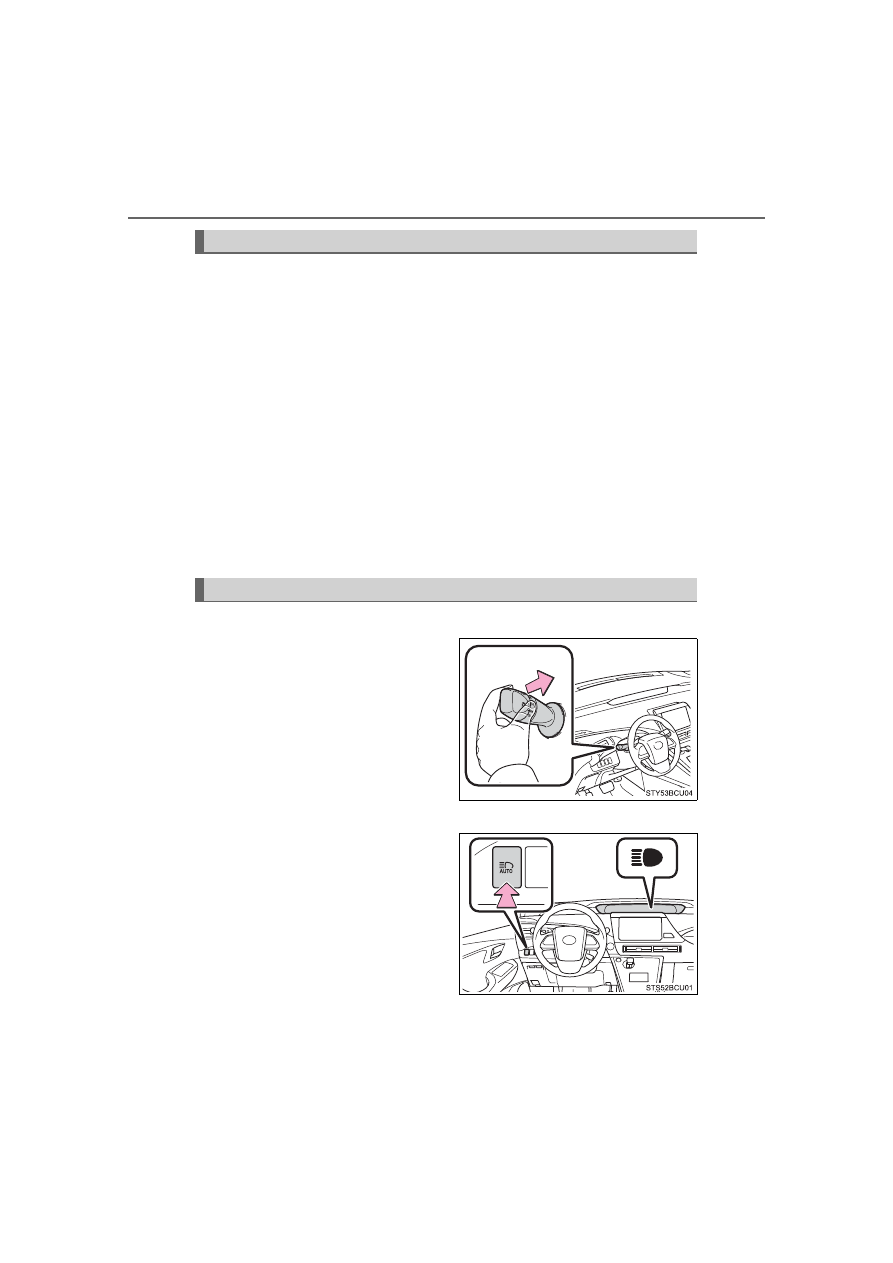
206
5-3. Operating the lights and wipers
MIRAI_OM_USA_OM62073U
When all of the following conditions are fulfilled, high beam will be
automatically turned on:
●
Vehicle speed is above approximately 21 mph (34 km/h).
●
The area ahead of the vehicle is dark.
●
There are no oncoming or preceding vehicles with headlights or tail
lights turned on.
●
There are few streetlights on the road ahead.
If any of the following conditions are fulfilled, high beam will be auto-
matically turned off:
●
Vehicle speed drops below approximately 17 mph (27 km/h).
●
The area ahead of the vehicle is not dark.
●
Oncoming or preceding vehicles have headlights or tail lights
turned on.
●
There are many streetlights on the road ahead.
■
Switching to low beam
Pull the lever to the original
position.
The Automatic High Beam indi-
cator will turn off.
Push the lever away from you to
activate the Automatic High
Beam system again.
■
Switching to high beam
Press the Automatic High
Beam switch.
The Automatic High Beam indi-
cator will turn off and the high
beam indicator will turn on.
Press the switch to activate the
Automatic High Beam system
again.
High beam automatic turning on or off conditions
Turning the high beam on/off manually
-------------------------------------------------------------------------------------------------------------------------------------------------------------
207
5-3. Operating the lights and wipers
5
Drivin
MIRAI_OM_USA_OM62073U
■
The Automatic High Beam can be operated when
The power switch is in ON mode.
■
Camera sensor detection information
●
High beam may not be automatically turned off in the following situations:
• When oncoming vehicles suddenly appear from a curve
• When the vehicle is cut in front of by another
• When oncoming or preceding vehicles are hidden from sight due to
repeated curves, road dividers or roadside trees
●
High beam may be turned off if an oncoming vehicle that is using fog lights
without using the headlights is detected.
●
House lights, street lights, red traffic signals, and illuminated billboards or
signs may cause the high beam to turn off.
●
The following factors may affect the amount of time taken to turn high beam
on or off:
• The brightness of headlights, fog lights, and tail lights of oncoming and
preceding vehicles
• The movement and direction of oncoming and preceding vehicles
• When an oncoming or preceding vehicle only has operational lights on
one side
• When an oncoming or preceding vehicle is a two-wheeled vehicle
• The condition of the road (gradient, curve, condition of the road surface,
etc.)
• The number of passengers and amount of luggage
●
High beam may be turned on or off when unexpected by the driver.
-------------------------------------------------------------------------------------------------------------------------------------------------------------
208
5-3. Operating the lights and wipers
MIRAI_OM_USA_OM62073U
●
In the situations below, the system may not be able to correctly detect the
surrounding brightness levels, and may flash or expose nearby pedestrians
to the high beam. Therefore, you should consider turning the high beams on
or off manually rather than relying on the Automatic High Beam system.
• In bad weather (rain, snow, fog, sandstorms, etc.).
• The windshield is obscured by fog, mist, ice, dirt, etc.
• The windshield is cracked or damaged.
• The camera sensor is deformed or dirty.
• The camera sensor temperature is extremely high.
• Surrounding brightness levels are equal to those of headlights, tail lights
or fog lights.
• Vehicles ahead have headlights that are either switched off, dirty, are
changing color, or are not aimed properly.
• When driving through an area of intermittently changing brightness and
darkness.
• When frequently and repeatedly driving ascending/descending roads, or
roads with rough, bumpy or uneven surfaces (such as stone-paved
roads, gravel tracks, etc.).
• When frequently and repeatedly taking curves or driving on a winding
road.
• There is a highly reflective object ahead of the vehicle, such as a sign or
a mirror.
• The back of a vehicle ahead is highly reflective, such as a container on a
truck.
• The vehicle’s headlights are damaged or dirty.
• The vehicle is listing or tilting, due to a flat tire, a trailer being towed, etc.
• The driver believes that the high beam may be causing problems or dis-
tress to other drivers or pedestrians nearby.
WARNING
■
Limitations of the Automatic High Beam
Do not rely on the Automatic High Beam. Always drive safely, taking care to
observe your surroundings and turning high beam on or off manually if nec-
essary.
-------------------------------------------------------------------------------------------------------------------------------------------------------------

209
5-3. Operating the lights and wipers
5
Drivin
MIRAI_OM_USA_OM62073U
NOTICE
■
Notes when using the Automatic High Beam system
Observe the following to ensure that the Automatic High Beam functions
correctly.
●
Do not place items on the dashboard. There is a possibility that the cam-
era sensor will mistake items reflected in the windshield for streetlights,
the headlights of other vehicles, etc.
●
Do not install a parking tag or any other accessories near or around the
camera sensor.
●
Do not overload the vehicle.
●
Do not modify the vehicle.
●
If the windshield needs to be replaced, contact your Toyota dealer.
●
Do not touch the camera sensor.
●
Do not subject the camera sensor to a
strong impact.
●
Do not disassemble the camera sensor.
●
Do not spill liquid onto the camera sen-
sor.
●
Do not apply window tinting or stickers
to the camera sensor or the area of
windshield near the camera sensor.
-------------------------------------------------------------------------------------------------------------------------------------------------------------

210
5-3. Operating the lights and wipers
MIRAI_OM_USA_OM62073U
Windshield wipers and washer
Operating the
lever operates the wipers or washer as follows.
When “AUTO” is selected, the wipers will operate automatically when
the sensor detects falling rain. The system automatically adjusts wiper
timing in accordance with rain volume and vehicle speed.
*
1
or
*
2
Off
Rain-sensing operation
*
1
or
*
2
Low speed operation
*
1
or
*
2
High speed operation
*
1
or
*
2
Temporary operation
*
1
: For U.S.A.
*
2
: For Canada
The sensor sensitivity can be adjusted when “AUTO” is selected.
Increases the sensitivity
Decreases the sensitivity
Operating the wiper lever
-------------------------------------------------------------------------------------------------------------------------------------------------------------
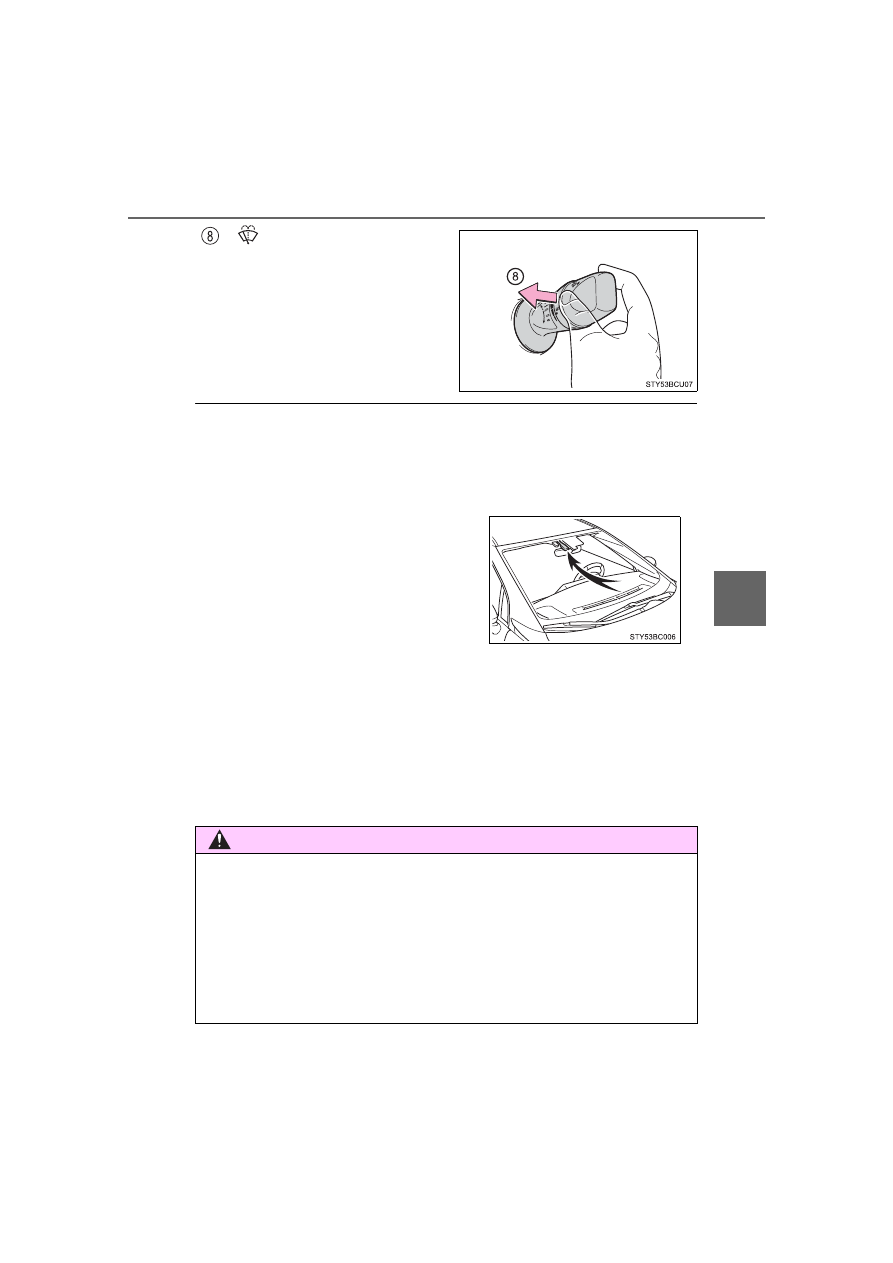
211
5-3. Operating the lights and wipers
5
Drivin
MIRAI_OM_USA_OM62073U
Washer/wiper dual oper-
ation
Pulling the lever operates the
wipers and washer.
Wipers will automatically operate a
couple of times after the washer
squirts.
■
The windshield wipers and washers can be operated when
The power switch is in ON mode.
■
Effects of vehicle speed on wiper operation
Vehicle speed affects the Intermittent wiper interval.
■
Raindrop sensor
●
If the wiper switch is turned to the “AUTO” position while the power switch is
in ON mode, the wipers will operate once to show that “AUTO” mode is acti-
vated.
●
If the temperature of the raindrop sensor is 194
F (90
C) or higher, or 5
F
(-15
C) or lower, automatic operation may not occur. In this case, operate
the wipers in any mode other than “AUTO” mode.
■
If no windshield washer fluid sprays
Check that the washer nozzles are not blocked, if there is washer fluid in the
windshield washer fluid reservoir.
●
The raindrop sensor judges the amount
of raindrops.
An optical sensor is adopted. It may not
operate properly when sunlight from the
rising or setting of the sun intermittently
strikes the windshield, or if bugs, etc.,
are present on the windshield.
WARNING
■
Caution regarding the use of windshield wipers in “AUTO” mode
The windshield wipers may operate unexpectedly if the sensor is touched or
the windshield is subject to vibration in “AUTO” mode. Take care that your
fingers, etc., do not become caught in the windshield wipers.
■
Caution regarding the use of washer fluid
When it is cold, do not use the washer fluid until the windshield becomes
warm. The fluid may freeze on the windshield and cause low visibility. This
may lead to an accident, resulting in death or serious injury.
-------------------------------------------------------------------------------------------------------------------------------------------------------------
212
5-3. Operating the lights and wipers
MIRAI_OM_USA_OM62073U
NOTICE
■
When the windshield is dry
Do not use the wipers, as they may damage the windshield.
■
When the washer fluid tank is empty
Do not operate the switch continually as the washer fluid pump may over-
heat.
■
When a nozzle becomes blocked
In this case, contact your Toyota dealer.
Do not try to clear it with a pin or other object. The nozzle will be damaged.
■
To prevent 12-volt battery discharge
Do not leave the wipers on longer than necessary when the fuel cell system
is off.
-------------------------------------------------------------------------------------------------------------------------------------------------------------
213
5
Drivin
MIRAI_OM_USA_OM62073U
Opening the fuel door
●
Close the all the doors and windows.
●
Set the parking brake.
●
Shift the shift position to P.
●
Turn the power switch off.
●
Turn off the headlights.
■
Fuel Type
Compressed hydrogen gas
■
Notes on fueling
●
Fueling will not be possible if the pressure inside the vehicle’s hydrogen tanks
is higher than the supply pressure of the hydrogen station. If the hydrogen
tanks are more than half full, the vehicle will be unable to fuel at a H35 dis-
penser.
A hydrogen station with a H70 dispenser (supply pressure of 10150 psi
[70 MPa, 714 kgf/cm
2
, 700 bar] is necessary to completely fill hydrogen tanks.
●
If the fueling cannot be completed due to trouble with the station equipment,
call the number indicated on the equipment.
●
Fuel with compressed hydrogen gas only at hydrogen stations.
●
Fuel at hydrogen stations conforming with the Society of Automo-
tive Engineers (SAE) J2601 fueling protocol or laws that may
supersede such SAE protocols.
●
Refer to the Mirai Station Finder Application in Connected ser-
vices, https://www.toyota.com/connected-services (for U.S. own-
ers) or https://www.toyota.ca/connected (for Canadian owners), or
call 1-800-331-4331 (for U.S. owners) or 1-888-869-6828 (for
Canadian owners).
●
Observe any notices or instructions shown at hydrogen stations.
●
The filling time and amount of fuel may depend on outside tem-
perature and the equipment at that hydrogen station.
●
Vehicles with expired hydrogen tanks must not be used. (
Consult your Toyota dealer.
Before filling
-------------------------------------------------------------------------------------------------------------------------------------------------------------
214
MIRAI_OM_USA_OM62073U
WARNING
■
When filling
Observe the following precautions while fueling the vehicle.
Failure to do so may result in death or serious injury.
●
Turn the power switch off before fueling.
●
Ensure the hydrogen gas nozzle is locked onto the vehicle receptacle
before filling. This can be done by pulling on the hydrogen gas nozzle to
check that it cannot be pulled off.
Failure to do so may result in injury or damage to the hydrogen gas nozzle
or vehicle.
●
Do not smoke while fueling.
●
Because the fuel is cold, the hydrogen gas nozzle and vehicle receptacle
surface will become cold, and frost may develop. After fueling is com-
pleted, remove the hydrogen gas nozzle by the plastic handle only. Do not
touch any other parts of the hydrogen gas nozzle or vehicle receptacle
with bare hands immediately after fueling, as frostbite may occur.
NOTICE
■
When filling
●
Fuel only with compressed hydrogen gas at stations compliant with the
Society of Automotive Engineers (SAE) J2601 fueling protocol or laws that
may supersede such SAE protocols.
If improper fuels are used, the fuel cell stack will be damaged.
●
Do not swing or drop the hydrogen gas nozzle, or subject it to a large
amount of force. Doing so may cause damage.
●
If the hydrogen gas nozzle cannot be removed after fueling, it may be fro-
zen to the vehicle receptacle. Wait for the hydrogen gas nozzle to thaw
before attempting to remove. Do not pull or rotate the hydrogen gas nozzle
forcibly. Failure to follow these precautions may cause damage.
●
Be sure to replace the cap after filling. If foreign material gets in the vehicle
receptacle, it may cause damage.
●
Do not put anything sharp, such as a screwdriver, blade, or any foreign
object into the mouth of the vehicle receptacle. If the vehicle receptacle is
damaged, hydrogen gas may leak during fueling.
●
If you notice anything unusual about the vehicle receptacle, please notify
your Toyota dealer.
●
If you notice anything unusual with the hydrogen dispenser or hydrogen
gas nozzle, please notify the hydrogen station operator. Contact informa-
tion is usually displayed on the dispenser.
-------------------------------------------------------------------------------------------------------------------------------------------------------------
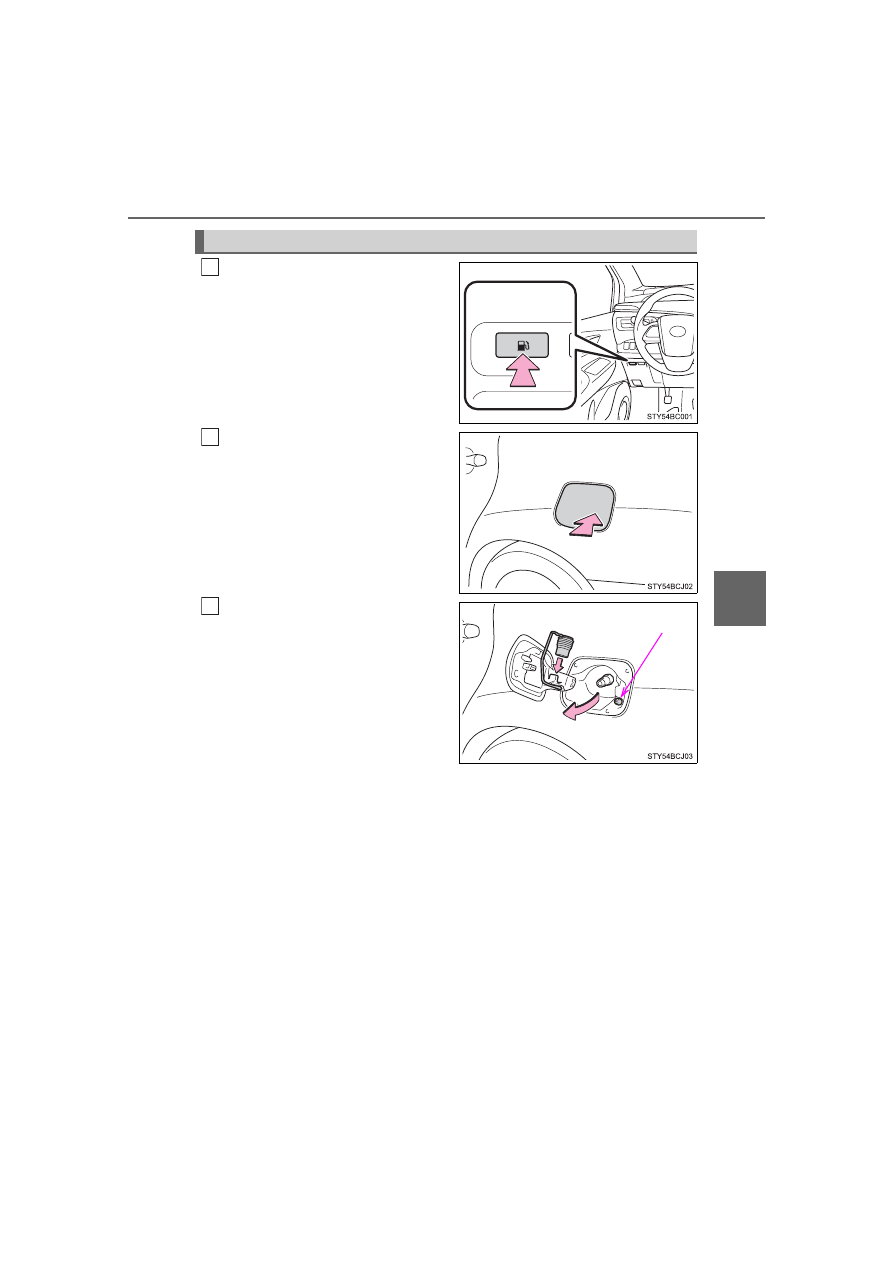
215
5
Drivin
MIRAI_OM_USA_OM62073U
Press the fuel door opener
switch to release the lock.
If the “READY” indicator is on or
the power switch is in ON mode,
the fuel door will not be unlocked.
Press the center part of the rear
edge of the fuel door.
Push inward, then release. The
fuel door will slightly open. It can
now be opened completely by pull-
ing on the fuel door.
Remove the cap and attach it to
the holder.
*
: Do not press the interlock button.
The fuel door sensor may malfunc-
tion.
Opening the fuel door
1
2
*
3
-------------------------------------------------------------------------------------------------------------------------------------------------------------

216
MIRAI_OM_USA_OM62073U
■
If “Open H2 Filler Door in a Safe Place when Vehicle is Powered OFF” is
displayed on the multi-information display
Stop the vehicle in a safe place and press the fuel door opener switch once
more with the following procedure:
Shift the shift position to P.
Turn the power switch off.
Press the fuel door opener switch.
■
If the fuel door lock cannot be released (i.e., if it is damaged)
■
Sounds during filling
When fueling with compressed hydrogen gas, noises from gas flowing
through the hydrogen gas nozzle and hydrogen tank valves can sometimes
be heard. (
Replace the cap.
Turn the power switch off, remove the
trunk inner cover, and release the lock for
the fuel door by pulling the lever.
Closing the fuel door
1
2
3
1
-------------------------------------------------------------------------------------------------------------------------------------------------------------

217
5
Drivin
MIRAI_OM_USA_OM62073U
Press the center part of the rear
edge of the fuel door, closing
the fuel door, until it clicks.
Confirm the fuel door is completely
closed by checking that the fuel
door is flush with the body.
■
Safety features
When the fuel door is open, the fuel cell system will not start. When the
“READY” indicator is on, the fuel door will not open.
■
If “H2 Filler Door is open. Park Your Vehicle in a Safe Place and Close H2
Filler Door” is displayed on the multi-information display
The fuel door is open. Stop the vehicle in a safe place and close the fuel door.
■
If “Close H2 Filler Door and Restart Your Vehicle” is displayed on the
multi-information display
The fuel door is open and the fuel cell system cannot be started. Shift the shift
position to P and, turn the power switch off, then:
Check whether the cap has been reinstalled.
Close the fuel door by pressing the center part of the rear edge of the fuel
door, until it clicks.
If the warning message on the multi-information display turns off at this
time, there is no malfunction. However, if the display continues to show, the
sensor may be damaged. Have the vehicle inspected by your Toyota
dealer.
2
1
2
-------------------------------------------------------------------------------------------------------------------------------------------------------------
218
5-5. Using the driving support systems
MIRAI_OM_USA_OM62073U
Toyota Safety Sense 2.0
■
PCS (Pre-Collision System)
■
LDA (Lane Departure Alert with steering control)
■
Automatic High Beam
■
RSA (Road Sign Assist) (if equipped)
■
Dynamic radar cruise control
The Toyota Safety Sense 2.0 consists of the following drive
assist systems and contributes to a safe and comfortable driv-
ing experience:
Driving assist system
WARNING
■
Toyota Safety Sense 2.0
The Toyota Safety Sense 2.0 is designed to operate under the assumption
that the driver will drive safely, and is designed to help reduce the impact to
the occupants and the vehicle in the case of a collision or assist the driver in
normal driving conditions.
As there is a limit to the degree of recognition accuracy and control perfor-
mance that this system can provide, do not overly rely on this system. The
driver is always responsible for paying attention to the vehicle’s surround-
ings and driving safely.
-------------------------------------------------------------------------------------------------------------------------------------------------------------

219
5-5. Using the driving support systems
5
Drivin
MIRAI_OM_USA_OM62073U
Two types of sensors, located behind the front grille and windshield,
detect information necessary to operate the drive assist systems.
Radar sensor
Front camera
Sensors
WARNING
■
To avoid malfunction of the radar sensor
Observe the following precautions.
Otherwise, the radar sensor may not operate properly, possibly leading to
an accident resulting in death or serious injury.
●
Keep the radar sensor and the grille cover clean at all times.
Radar sensor
Grille cover
If the front of the radar sensor or the
front or back of the grille cover is dirty
or covered with water droplets, snow,
etc., clean it.
Clean the radar sensor and grille
cover with a soft cloth to avoid dam-
aging them.
-------------------------------------------------------------------------------------------------------------------------------------------------------------
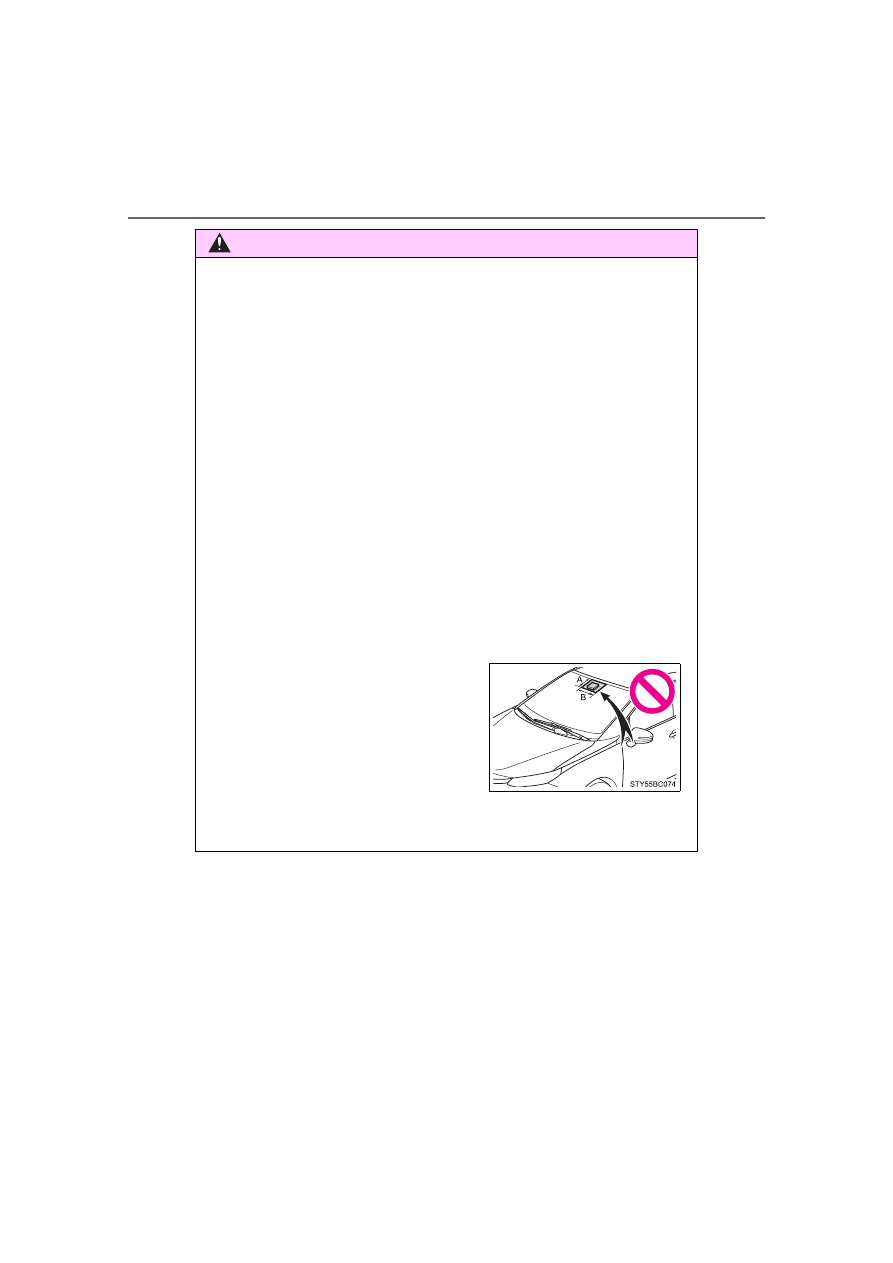
220
5-5. Using the driving support systems
MIRAI_OM_USA_OM62073U
WARNING
●
Do not attach accessories, stickers (including transparent stickers) or
other items to the radar sensor, grille cover or surrounding area.
●
Do not subject the radar sensor or its surrounding area to a strong impact.
If the radar sensor, front grille, or front bumper has been subjected to a
strong impact, have the vehicle inspected by your Toyota dealer.
●
Do not disassemble the radar sensor.
●
Do not modify or paint the radar sensor or grille cover.
●
If the radar sensor, front grille, or front bumper needs to be removed and
installed, or replaced, contact your Toyota dealer.
■
To avoid malfunction of the front camera
Observe the following precautions.
Otherwise, the front camera may not operate properly, possibly leading to
an accident resulting in death or serious injury.
●
Keep the windshield clean at all times.
• If the windshield is dirty or covered with an oily film, water droplets,
snow, etc., clean the windshield.
• If a glass coating agent is applied to the windshield, it will still be neces-
sary to use the windshield wipers to remove water droplets, etc., from
the area of the windshield in front of the front camera.
• If the inner side of the windshield where the front camera is installed is
dirty, contact your Toyota dealer.
B: Approximately 7.9 in. (20 cm) (Approximately 4.0 in. [10 cm] to the
right and left from the center of the front camera)
●
Do not attach objects, such as stickers,
transparent stickers, etc., to the outer
side of the windshield in front of the
front camera (shaded area in the illus-
tration).
A: From the top of the windshield to
approximately 0.4 in. (1 cm) below
the bottom of the front camera
-------------------------------------------------------------------------------------------------------------------------------------------------------------
221
5-5. Using the driving support systems
5
Drivin
MIRAI_OM_USA_OM62073U
WARNING
●
If the part of the windshield in front of the front camera is fogged up or cov-
ered with condensation or ice, use the windshield defogger to remove the
fog, condensation or ice. (
●
If water droplets cannot be properly removed from the area of the wind-
shield in front of the front camera by the windshield wipers, replace the
wiper insert or wiper blade.
If the wiper inserts or wiper blades need to be replaced, contact your
Toyota dealer.
●
Do not attach window tint to the windshield.
●
Replace the windshield if it is damaged or cracked.
If the windshield needs to be replaced, contact your Toyota dealer.
●
Do not allow liquids to contact the front camera.
●
Do not allow bright lights to shine into the front camera.
●
Do not dirty or damage the front camera.
When cleaning the inside of the windshield, do not allow glass cleaner to
contact the lens of the front camera. Also, do not touch the lens.
If the lens is dirty or damaged, contact your Toyota dealer.
●
Do not subject the front camera to a strong impact.
●
Do not change the installation position or direction of the front camera or
remove it.
●
Do not disassemble the front camera.
●
Do not modify any components of the vehicle around the front camera
(inside rear view mirror, etc.) or ceiling.
●
Do not attach any accessories to the hood, front grille or front bumper that
may obstruct the front camera. Contact your Toyota dealer for details.
●
If a surfboard or other long object is to be mounted on the roof, make sure
that it will not obstruct the front camera.
●
Do not modify the headlights or other lights.
-------------------------------------------------------------------------------------------------------------------------------------------------------------
222
5-5. Using the driving support systems
MIRAI_OM_USA_OM62073U
■
Certification for Toyota Safety Sense 2.0
For U.S.A.
-------------------------------------------------------------------------------------------------------------------------------------------------------------
-------------------------------------------------------------------------------------------------------------------------------------------------------------
224
5-5. Using the driving support systems
MIRAI_OM_USA_OM62073U
■
If a warning message is displayed on the multi-information display
A system may be temporarily unavailable or there may be a malfunction in
the system.
●
In the following situations, perform the actions specified in the table. When
the normal operating conditions are detected, the message will disappear
and the system will become operational.
If the message does not disappear, contact your Toyota dealer.
Situation
Actions
When the area around a sensor is
covered with dirt, moisture (fogged
up, covered with condensation, ice,
etc.), or other foreign matter
To clean the part of the windshield in
front of the front camera, use the
windshield wipers or the windshield
defogger of the air conditioning sys-
tem (
When the temperature around the
front camera is outside of the opera-
tional range, such as when the vehi-
cle is in the sun or in an extremely
cold environment
If the front camera is hot, such as
after the vehicle had been parked in
the sun, use the air conditioning sys-
tem to decrease the temperature
around the front camera.
If a sunshade was used when the
vehicle was parked, depending on its
type, the sunlight reflected from the
surface of the sunshade may cause
the temperature of the front camera
to become excessively high.
If the front camera is cold, such after
the vehicle is parked in an extremely
cold environment, use the air condi-
tioning system to increase the tem-
perature around the front camera.
The area in front of the front camera
is obstructed, such as when the hood
is open or a sticker is attached to the
part of the windshield in front of the
front camera.
Close the hood, remove the sticker,
etc. to clear the obstruction.
-------------------------------------------------------------------------------------------------------------------------------------------------------------
225
5-5. Using the driving support systems
5
Drivin
MIRAI_OM_USA_OM62073U
●
In the following situations, if the situation has changed (or the vehicle has
been driven for some time) and the normal operating conditions are
detected, the message will disappear and the system will become opera-
tional.
If the message does not disappear, contact your Toyota dealer.
• When the temperature around the radar sensor is outside of the opera-
tional range, such as when the vehicle is in the sun or in an extremely
cold environment
• When the front camera cannot detect objects in front of the vehicle, such
as when driving in the dark, snow, or fog, or when bright lights are shining
into the front camera
-------------------------------------------------------------------------------------------------------------------------------------------------------------
226
5-5. Using the driving support systems
MIRAI_OM_USA_OM62073U
PCS (Pre-Collision system)
The system can detect the following:
●
Vehicles
●
Bicyclists
●
Pedestrians
The pre-collision system uses a radar sensor and front camera
to detect objects (
P. 226) in front of the vehicle. When the sys-
tem determines that the possibility of a frontal collision with an
object is high, a warning operates to urge the driver to take eva-
sive action and the potential brake pressure is increased to help
the driver avoid the collision. If the system determines that the
possibility of a frontal collision with an object is extremely high,
the brakes are automatically applied to help avoid the collision
or help reduce the impact of the collision.
The pre-collision system can be disabled/enabled and the warning
timing can be changed. (
Detectable objects
-------------------------------------------------------------------------------------------------------------------------------------------------------------
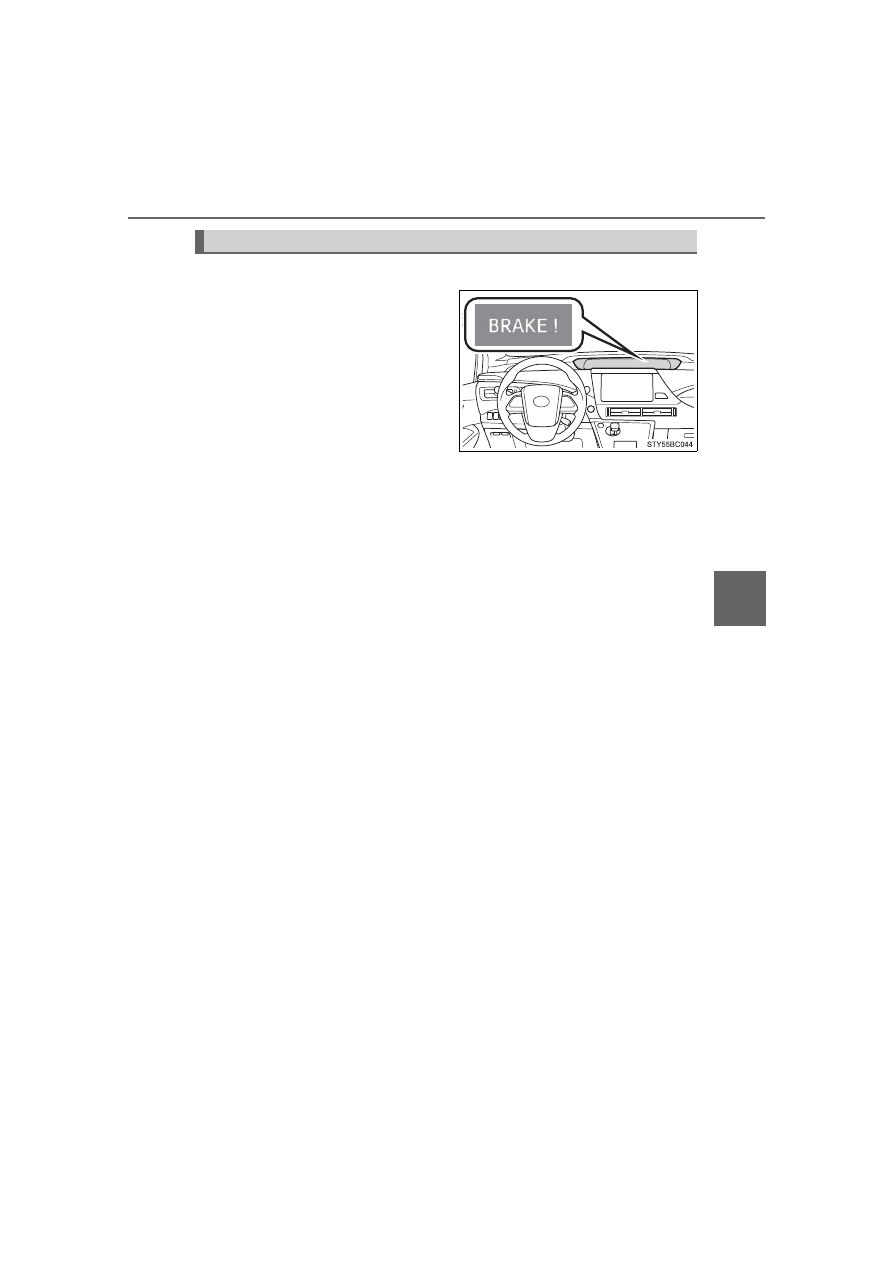
227
5-5. Using the driving support systems
5
Drivin
MIRAI_OM_USA_OM62073U
■
Pre-collision warning
When the system determines
that the possibility of a frontal
collision is high, a buzzer will
sound and a warning message
will be displayed on the multi-
information display to urge the
driver to take evasive action.
■
Pre-collision brake assist
When the system determines that the possibility of a frontal colli-
sion is high, the system applies greater braking force in relation to
how strongly the brake pedal is depressed.
■
Pre-collision braking
If the system determines that the possibility of a frontal collision is
extremely high, the brakes are automatically applied to help avoid
the collision or reduce the impact of the collision.
System functions
-------------------------------------------------------------------------------------------------------------------------------------------------------------
228
5-5. Using the driving support systems
MIRAI_OM_USA_OM62073U
WARNING
■
Limitations of the pre-collision system
●
The driver is solely responsible for safe driving. Always drive safely, taking
care to observe your surroundings. Do not use the pre-collision system
instead of normal braking operations under any circumstances. This sys-
tem will not prevent collisions or lessen collision damage or injury in every
situation. Do not overly rely on this system. Failure to do so may lead to an
accident, resulting in death or serious injury.
●
Although this system is designed to help avoid a collision or help reduce
the impact of the collision, its effectiveness may change according to vari-
ous conditions, therefore the system may not always be able to achieve
the same level of performance.
Read the following conditions carefully. Do not overly rely on this system
and always drive carefully.
• Conditions under which the system may operate even if there is no pos-
sibility of a collision:
• Conditions under which the system may not operate properly:
●
Do not attempt to test the operation of the pre-collision system yourself.
Depending on the objects used for testing (dummies, cardboard objects
imitating detectable objects, etc.), the system may not operate properly,
possibly leading to an accident.
■
Pre-collision braking
●
When the pre-collision braking function is operating, a large amount of
braking force will be applied.
●
If the vehicle is stopped by the operation of the pre-collision braking func-
tion, the pre-collision braking function operation will be canceled after
approximately 2 seconds.
Depress the brake pedal as necessary.
●
The pre-collision braking function may not operate if certain operations are
performed by the driver. If the accelerator pedal is being depressed
strongly or the steering wheel is being turned, the system may determine
that the driver is taking evasive action and possibly prevent the pre-colli-
sion braking function from operating.
●
In some situations, while the pre-collision braking function is operating,
operation of the function may be canceled if the accelerator pedal is
depressed strongly or the steering wheel is turned and the system deter-
mines that the driver is taking evasive action.
●
If the brake pedal is being depressed, the system may determine that the
driver is taking evasive action and possibly delay the operation timing of
the pre-collision braking function.
-------------------------------------------------------------------------------------------------------------------------------------------------------------
229
5-5. Using the driving support systems
5
Drivin
MIRAI_OM_USA_OM62073U
WARNING
■
When to disable the pre-collision system
In the following situations, disable the system, as it may not operate prop-
erly, possibly leading to an accident resulting in death or serious injury:
●
When the vehicle is being towed
●
When your vehicle is towing another vehicle
●
When transporting the vehicle via truck, boat, train or similar means of
transportation
●
When the vehicle is raised on a lift with the fuel cell system on and the tires
are allowed to rotate freely
●
When inspecting the vehicle using a drum tester such as a chassis dyna-
mometer or speedometer tester, or when using an on vehicle wheel bal-
ancer
●
When a strong impact is applied to the front bumper or front grille, due to
an accident or other reasons
●
If the vehicle cannot be driven in a stable manner, such as when the vehi-
cle has been in an accident or is malfunctioning
●
When the vehicle is driven in a sporty manner or off-road
●
When the tires are not properly inflated
●
When the tires are very worn
●
When tires of a size other than specified are installed
●
When tire chains are installed
●
When a compact spare tire or an emergency tire puncture repair kit is used
●
If equipment (snow plow, etc.) that may obstruct the radar sensor or front
camera is temporarily installed to the vehicle
-------------------------------------------------------------------------------------------------------------------------------------------------------------
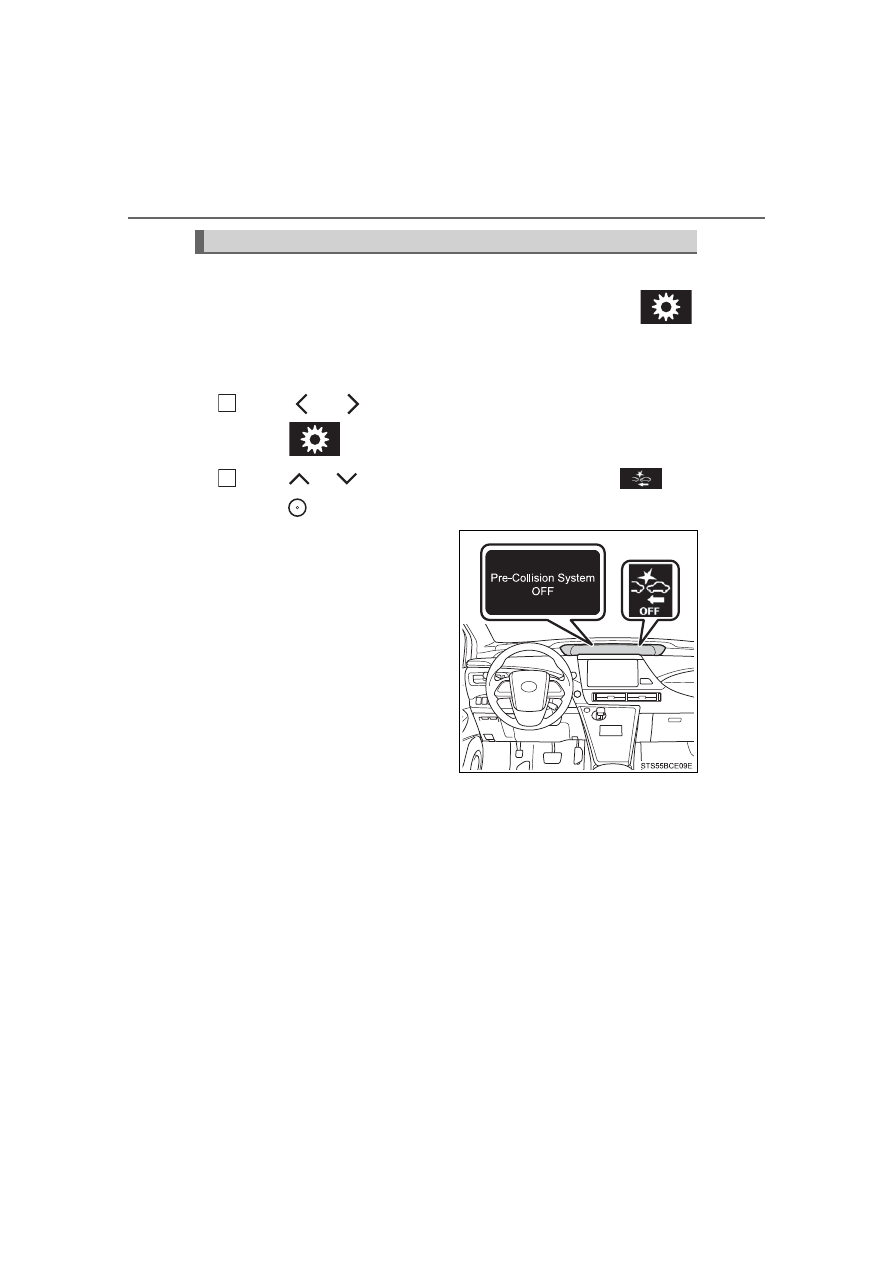
230
5-5. Using the driving support systems
MIRAI_OM_USA_OM62073U
■
Enabling/disabling the pre-collision system
The pre-collision system can be enabled/disabled on
(
P. 124) of the multi-information display.
The system is automatically enabled each time the power switch is
turned to ON mode.
Press
or
of the meter control switches (
P. 118) and
select
.
Press
or
of the meter control switches, select
and
press
to select the desired setting (on/off).
If the system is disabled, the
PCS warning light will turn on
and a message will be dis-
played on the multi-information
display.
Changing settings of the pre-collision system
1
2
-------------------------------------------------------------------------------------------------------------------------------------------------------------

231
5-5. Using the driving support systems
5
Drivin
MIRAI_OM_USA_OM62073U
■
Changing the pre-collision warning timing
The pre-collision warning timing can be changed on
(
P. 124) of the multi-information display.
Press
or
of the meter control switches (
P. 118) and
select
.
Press
or
of the meter control switches, select
and
press
to select the desired setting.
Early
Middle
This is the default setting.
Late
The warning timing setting is
retained when the power switch is
turned off. However, if the pre-colli-
sion system is disabled and re-
enabled, the operation timing will
return to the default setting (mid-
dle).
1
2
-------------------------------------------------------------------------------------------------------------------------------------------------------------

232
5-5. Using the driving support systems
MIRAI_OM_USA_OM62073U
■
Operational conditions
The pre-collision system is enabled and the system determines that the pos-
sibility of a frontal collision with a detected object is high.
Each function is operational at the following speed
●
Pre-collision warning
●
Pre-collision brake assist
●
Pre-collision braking
The system may not operate in the following situations:
●
If a 12-volt battery terminal has been disconnected and reconnected and then
the vehicle has not been driven for a certain amount of time
●
If the shift position is in R
●
When the VSC OFF indicator is illuminated (only the pre-collision warning func-
tion will be operational)
Detectable objects
Vehicle speed
Relative speed between
your vehicle and object
Vehicles
Approx. 7 to 110 mph
(10 to 180 km/h)
Approx. 7 to 110 mph
(10 to 180 km/h)
Bicyclists and pedestri-
ans
Approx. 7 to 50 mph
(10 to 80 km/h)
Approx. 7 to 50 mph
(10 to 80 km/h)
Detectable objects
Vehicle speed
Relative speed between
your vehicle and object
Vehicles
Approx. 20 to 110 mph
(30 to 180 km/h)
Approx. 20 to 110 mph
(30 to 180 km/h)
Bicyclists and pedestri-
ans
Approx. 20 to 50 mph
(30 to 80 km/h)
Approx. 20 to 50 mph
(30 to 80 km/h)
Detectable objects
Vehicle speed
Relative speed between
your vehicle and object
Vehicles
Approx. 7 to 110 mph
(10 to 180 km/h)
Approx. 7 to 110 mph
(10 to 180 km/h)
Bicyclists and pedestri-
ans
Approx. 7 to 50 mph
(10 to 80 km/h)
Approx. 7 to 50 mph
(10 to 80 km/h)
-------------------------------------------------------------------------------------------------------------------------------------------------------------
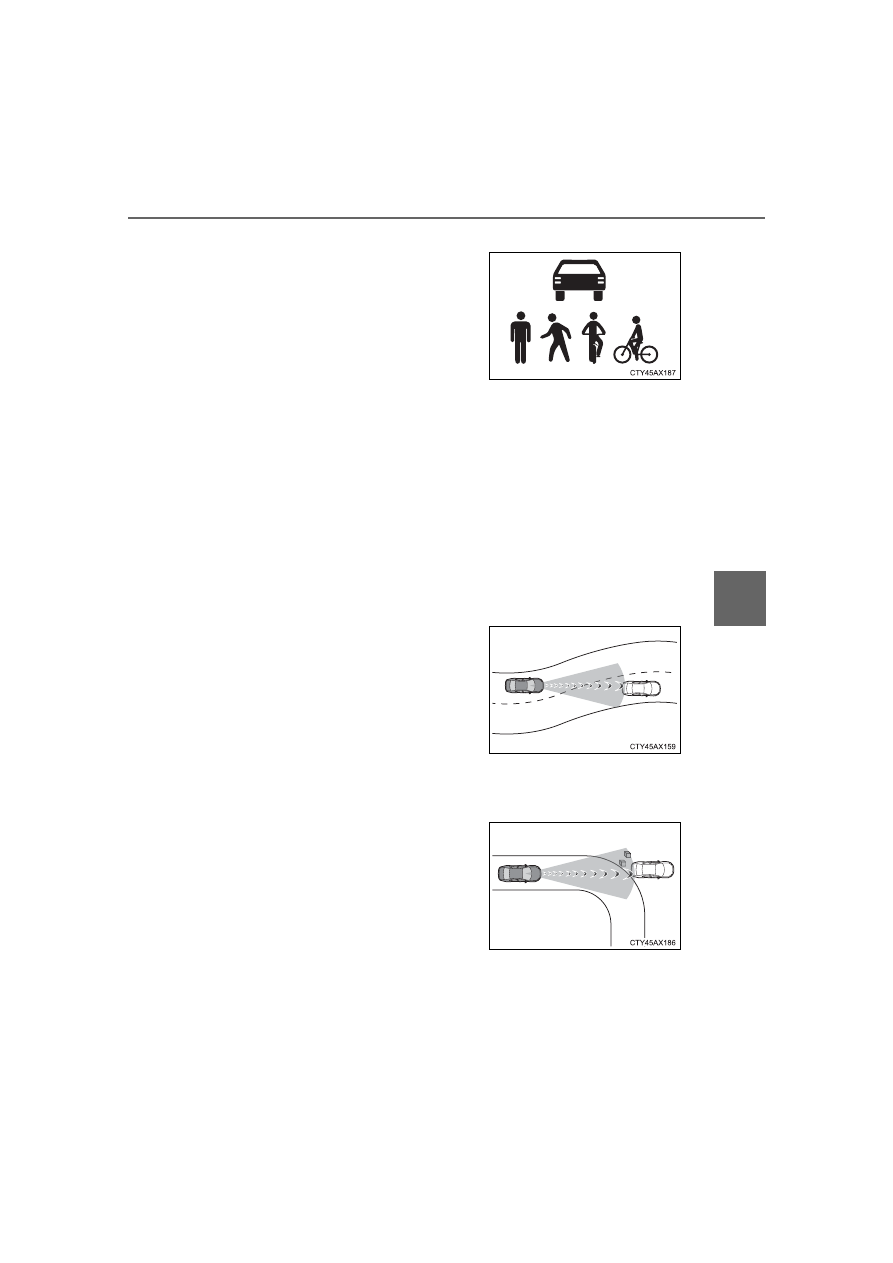
233
5-5. Using the driving support systems
5
Drivin
MIRAI_OM_USA_OM62073U
■
Object detection function
■
Cancelation of the pre-collision braking
If either of the following occur while the pre-collision braking function is oper-
ating, it will be canceled:
●
The accelerator pedal is depressed strongly.
●
The steering wheel is turned sharply or abruptly.
■
Conditions under which the system may operate even if there is no pos-
sibility of a collision
●
In some situations such as the following, the system may determine that
there is a possibility of a frontal collision and operate.
• When passing a detectable object, etc.
• When changing lanes while overtaking a detectable object, etc.
• When rapidly closing on a detectable object, etc.
• When approaching objects on the roadside, such as detectable objects,
guardrails, utility poles, trees, or walls
The system detects objects based on
their size, profile, motion, etc. However,
an object may not be detected depending
on the surrounding brightness and the
motion, posture, and angle of the
detected object, preventing the system
from operating properly. (
P. 235) The
illustration shows an image of detectable
objects.
• When approaching a detectable
object in an adjacent lane or on the
roadside, such as when changing the
course of travel or driving on a wind-
ing road
• When there is a detectable object or
other object by the roadside at the
entrance of a curve
-------------------------------------------------------------------------------------------------------------------------------------------------------------
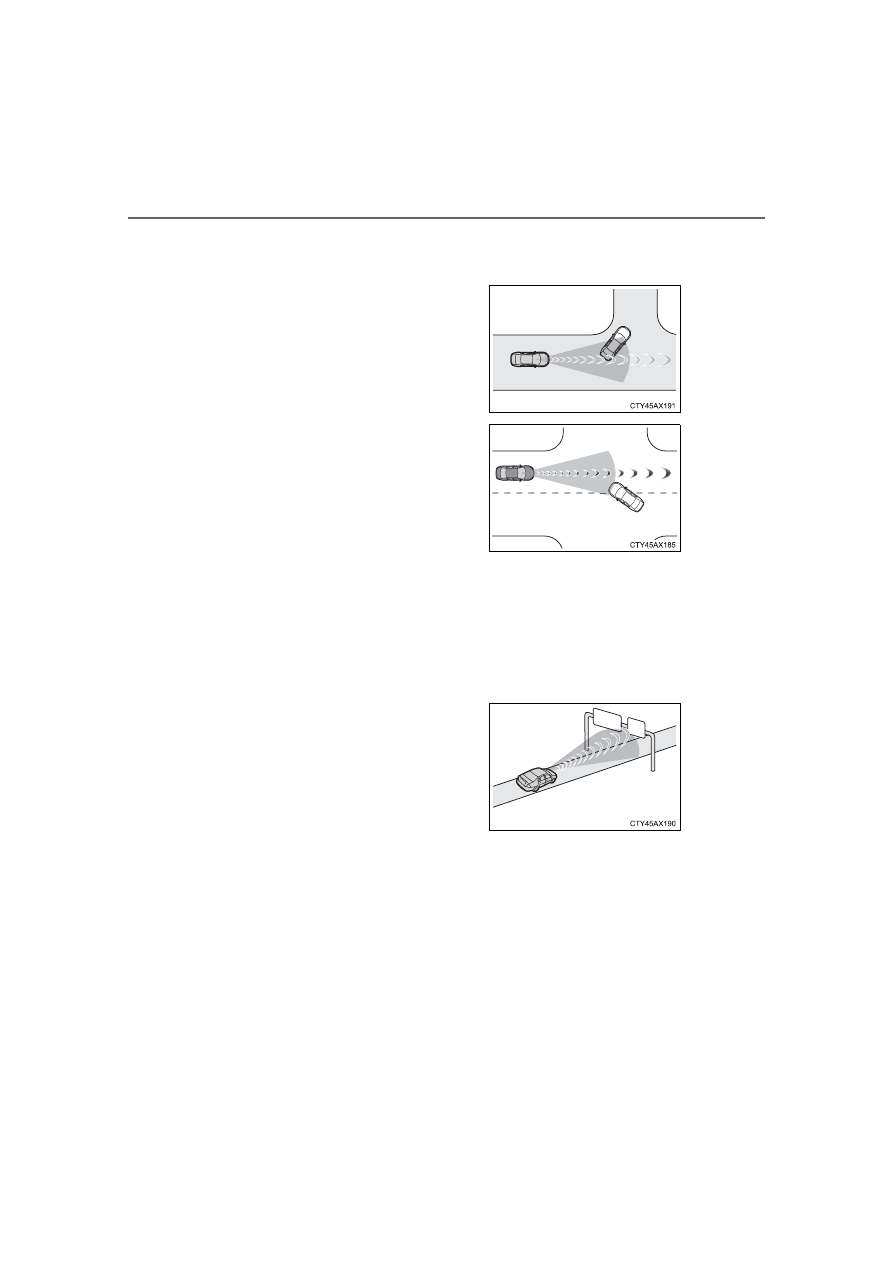
234
5-5. Using the driving support systems
MIRAI_OM_USA_OM62073U
• When there are patterns or paint in front of your vehicle that may be mis-
taken for a detectable object
• When the front of your vehicle is hit by water, snow, dust, etc.
• When a detectable object approaches very close and then stops before
entering the path of your vehicle
• If the front of your vehicle is raised or lowered, such as when on an
uneven or undulating road surface
• When driving on a road surrounded by a structure, such as in a tunnel or
on an iron bridge
• When there is a metal object (manhole cover, steel plate, etc.), steps, or a
protrusion in front of your vehicle
• When approaching an electric toll gate barrier, parking area barrier, or
other barrier that opens and closes
• When using an automatic car wash
• When overtaking a detectable object
that is changing lanes or making a
right/left turn
• When passing a detectable object in
an oncoming lane that is stopped to
make a right/left turn
• When passing under an object (road
sign, billboard, etc.)
-------------------------------------------------------------------------------------------------------------------------------------------------------------

235
5-5. Using the driving support systems
5
Drivin
MIRAI_OM_USA_OM62073U
• When driving through steam or smoke
• When driving near an object that reflects radio waves, such as a large
truck or guardrail
• When driving near a TV tower, broadcasting station, electric power plant,
or other location where strong radio waves or electrical noise may be
present
■
Situations in which the system may not operate properly
●
In some situations such as the following, an object may not be detected by
the radar sensor and front camera, preventing the system from operating
properly:
• When a detectable object is approaching your vehicle
• When your vehicle or a detectable object is wobbling
• If a detectable object makes an abrupt maneuver (such as sudden swerv-
ing, acceleration or deceleration)
• When your vehicle approaches a detectable object rapidly
• When a detectable object is near a wall, fence, guardrail, manhole cover,
vehicle, steel plate on the road, etc.
• When a detectable object is under a structure
• When part of a detectable object is hidden by an object, such as large
baggage, an umbrella, or guardrail
• When multiple detectable objects are close together
• If the sun or other light is shining directly on a detectable object
• When a detectable object is a shade of white and looks extremely bright
• When driving through or under
objects that may contact your vehicle,
such as thick grass, tree branches, or
a banner
• When a detectable object is not
directly in front of your vehicle
-------------------------------------------------------------------------------------------------------------------------------------------------------------
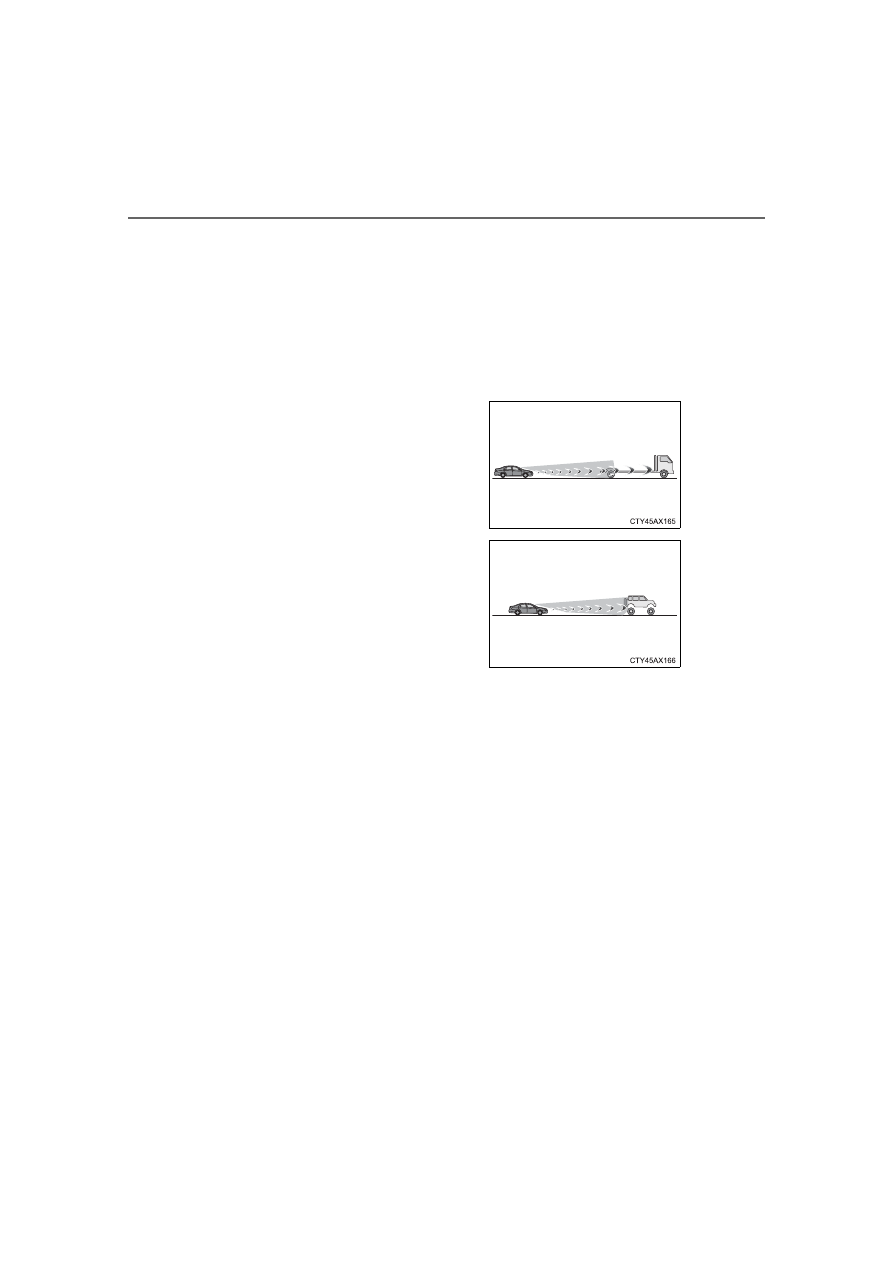
236
5-5. Using the driving support systems
MIRAI_OM_USA_OM62073U
• When a detectable object appears to be nearly the same color or bright-
ness as its surroundings
• If a detectable object cuts or suddenly emerges in front of your vehicle
• When the front of your vehicle is hit by water, snow, dust, etc.
• When a very bright light ahead, such as the sun or the headlights of
oncoming traffic, shines directly into the front camera
• When approaching the side or front of a vehicle ahead
• If a vehicle ahead is a motorcycle
• If a vehicle ahead is narrow, such as a personal mobility vehicle
• If a preceding vehicle has a small rear end, such as an unloaded truck
• If a vehicle ahead is carrying a load which protrudes past its rear bumper
• If a vehicle ahead is irregularly shaped, such as a tractor or side car
• If a vehicle ahead is a child sized bicycle, a bicycle that is carrying a large
load, a bicycle ridden by more than one person, or a uniquely shaped
bicycle (bicycle with a child seat, tandem bicycle, etc.)
• If a pedestrian/or the riding height of a bicyclist ahead is shorter than
approximately 3.2 ft. (1 m) or taller than approximately 6.5 ft. (2 m)
• If a pedestrian/bicyclist is wearing oversized clothing (a rain coat, long
skirt, etc.), making their silhouette obscure
• If a pedestrian is bending forward or squatting or bicyclist is bending for-
ward
• If a pedestrian/bicyclist is moving fast
• If a pedestrian is pushing a stroller, wheelchair, bicycle or other vehicle
• When driving in inclement weather such as heavy rain, fog, snow or a
sandstorm
• If a preceding vehicle has a low rear
end, such as a low bed trailer
• If a vehicle ahead has extremely high
ground clearance
-------------------------------------------------------------------------------------------------------------------------------------------------------------

237
5-5. Using the driving support systems
5
Drivin
MIRAI_OM_USA_OM62073U
• When driving through steam or smoke
• When the surrounding area is dim, such as at dawn or dusk, or while at
night or in a tunnel, making a detectable object appear to be nearly the
same color as its surroundings
• When driving in a place where the surrounding brightness changes sud-
denly, such as at the entrance or exit of a tunnel
• After the fuel cell system has started the vehicle has not been driven for a
certain amount of time
• While making a left/right turn and for a few seconds after making a left/
right turn
• While driving on a curve and for a few seconds after driving on a curve
• If your vehicle is skidding
• If the wheels are misaligned
• If a wiper blade is blocking the front camera
• The vehicle is being driven at extremely high speeds
• When driving on a hill
• If the radar sensor or front camera is misaligned
●
In some situations such as the following, sufficient braking force may not be
obtained, preventing the system from performing properly:
• If the braking functions cannot operate to their full extent, such as when
the brake parts are extremely cold, extremely hot, or wet
• If the vehicle is not properly maintained (brakes or tires are excessively
worn, improper tire inflation pressure, etc.)
• When the vehicle is being driven on a gravel road or other slippery sur-
face
■
If VSC is disabled
●
If VSC is disabled (
P. 297), the pre-collision brake assist and pre-collision
braking functions are also disabled.
●
The PCS warning light will turn on and “VSC Turned Off Pre-Collision Brake
System Unavailable” will be displayed on the multi-information display.
• If the front of the vehicle is raised or
lowered
-------------------------------------------------------------------------------------------------------------------------------------------------------------
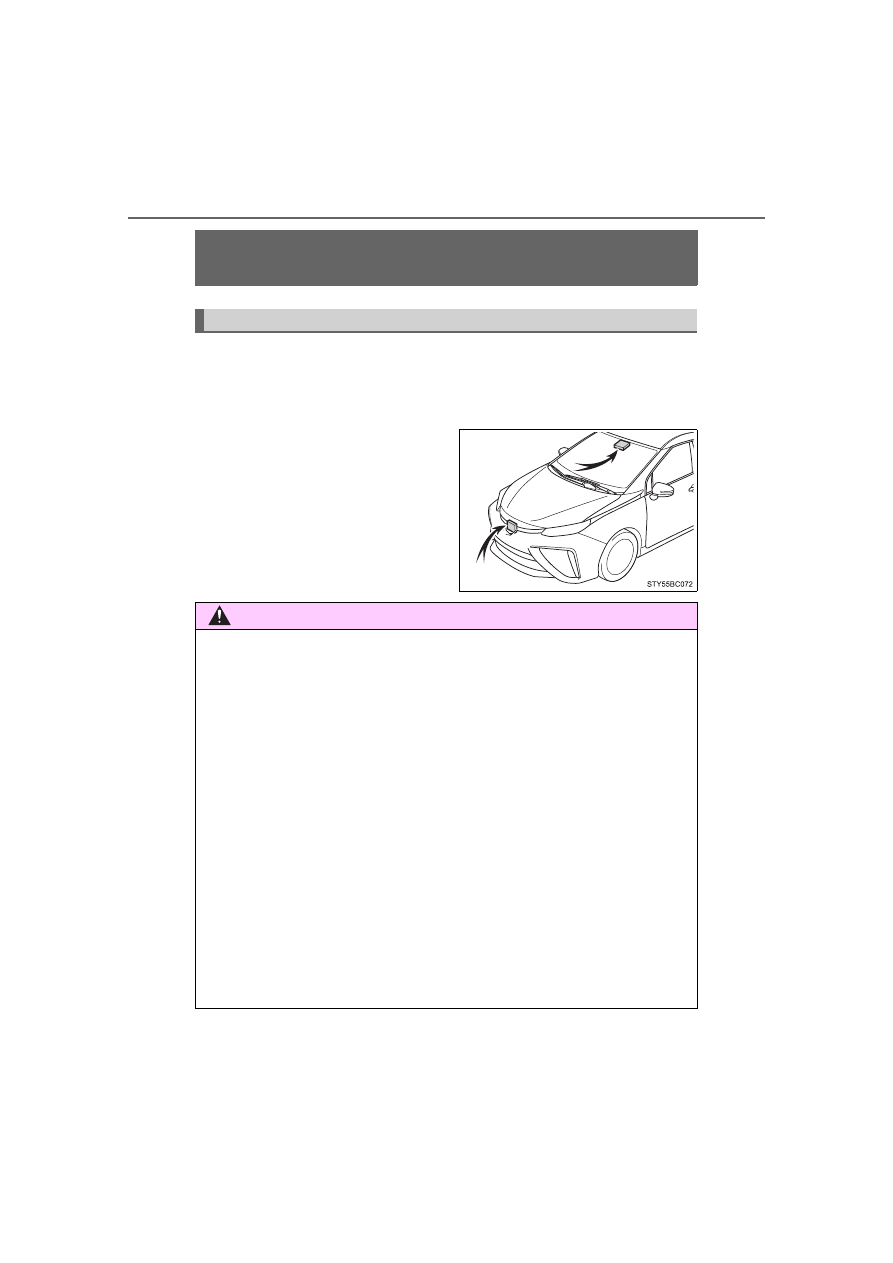
238
5-5. Using the driving support systems
MIRAI_OM_USA_OM62073U
LDA (Lane Departure Alert with steering
control)
When driving on highways and freeways with white (yellow) lane
lines, this function alerts the driver when the vehicle might depart from
its lane or course
*
and provides assistance by operating the steering
wheel to keep the vehicle in its lane or course
*
.
The LDA system recognizes white
(yellow) lane lines or a course
*
using the front camera. Addition-
ally, it detects preceding vehicles
using the front camera and radar.
*
: Boundary between asphalt and the
side of the road, such as grass, soil,
or a curb
Summary of functions
WARNING
■
Before using LDA system
●
Do not rely solely upon the LDA system. The LDA system does not auto-
matically drive the vehicle or reduce the amount of attention that must be
paid to the area in front of the vehicle. The driver must always assume full
responsibility for driving safely by paying careful attention to the surround-
ing conditions and operating the steering wheel to correct the path of the
vehicle. Also, the driver must take adequate breaks when fatigued, such
as from driving for a long period of time.
●
Failure to perform appropriate driving operations and pay careful attention
may lead to an accident, resulting in death or serious injury.
●
When not using the LDA system, use the LDA switch to turn the system
off.
■
Situations unsuitable for LDA system
In the following situations, use the LDA switch to turn the system off. Failure
to do so may lead to an accident, resulting in death or serious injury.
●
Vehicle is driven on a road surface which is slippery due to rainy weather,
fallen snow, freezing, etc.
●
Vehicle is driven on a snow-covered road.
●
White (yellow) lines are difficult to see due to rain, snow, fog, dust, etc.
●
A spare tire, tire chains, etc. are equipped.
-------------------------------------------------------------------------------------------------------------------------------------------------------------
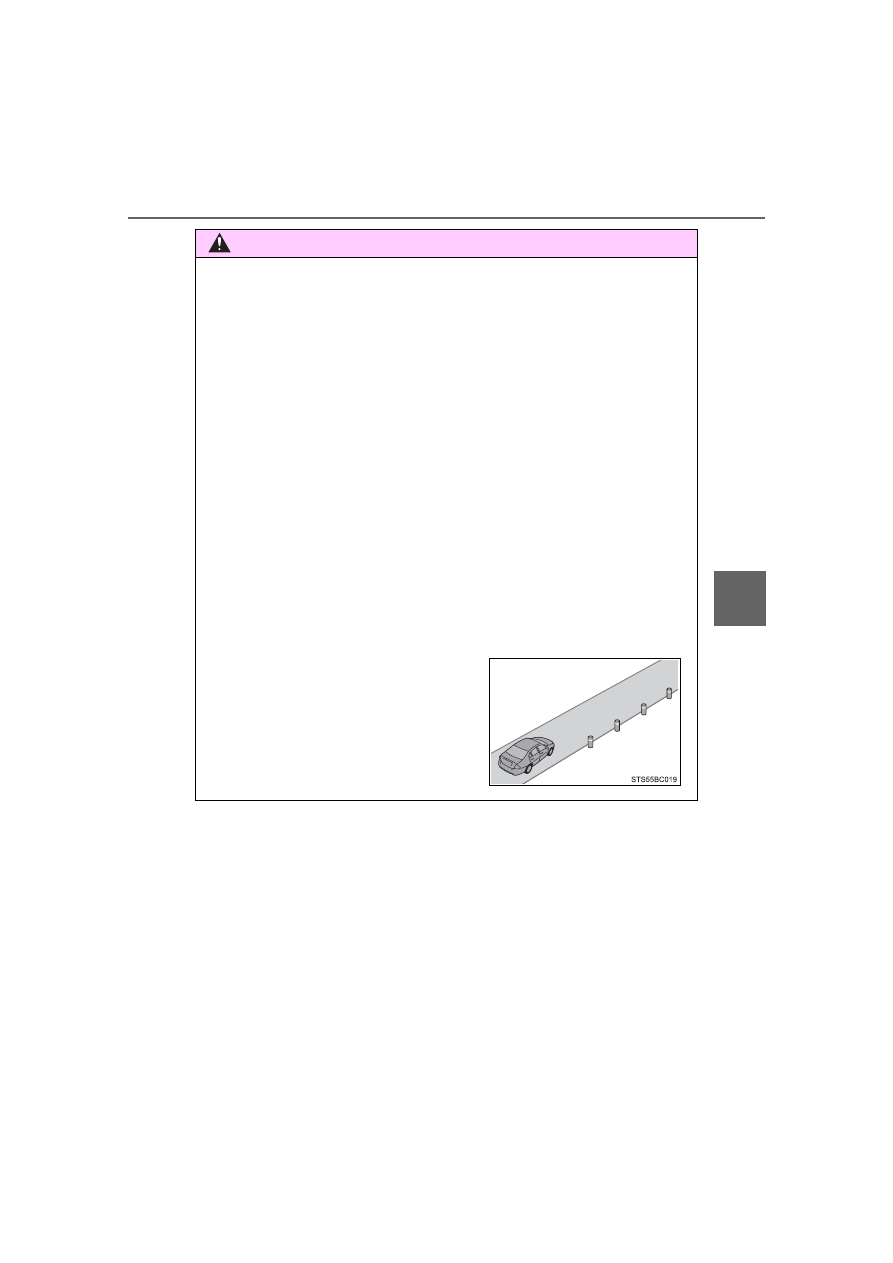
239
5-5. Using the driving support systems
5
Drivin
MIRAI_OM_USA_OM62073U
WARNING
●
When the tires have been excessively worn, or when the tire inflation pres-
sure is low.
●
When tires of a size other than specified are installed.
●
Vehicle is driven in traffic lanes other than that highways and freeways.
●
During emergency towing
■
Preventing LDA system malfunctions and operations performed by
mistake
●
Do not modify the headlights or place stickers, etc. on the surface of the
lights.
●
Do not modify the suspension etc. If the suspension etc. needs to be
replaced, contact your Toyota dealer.
●
Do not install or place anything on the hood or grille. Also, do not install a
grille guard (bull bars, kangaroo bar, etc.).
●
If your windshield needs repairs, contact your Toyota dealer.
■
Conditions in which functions may not operate properly
In the following situations, the functions may not operate properly and the
vehicle may depart from its lane. Drive safely by always paying careful
attention to your surroundings and operate the steering wheel to correct the
path of the vehicle without relying solely on the functions.
●
Vehicle is being driven around a sharp curve.
●
Objects or patterns that could be mis-
taken for white (yellow) lines are pres-
ent on the side of the road (guardrails,
reflective poles, etc.).
-------------------------------------------------------------------------------------------------------------------------------------------------------------

240
5-5. Using the driving support systems
MIRAI_OM_USA_OM62073U
WARNING
●
There are shadows on the road that run parallel with, or cover, the white
(yellow) lines.
●
The vehicle is driven in an area without white (yellow) lines, such as in
front of a tollgate or checkpoint, or at an intersection, etc.
●
The white (yellow) lines are cracked, “Botts’ dots”, “Raised pavement
marker” or stones are present.
●
The white (yellow) lines cannot be seen or are difficult to see due to sand,
etc.
●
The vehicle is driven on a road surface that is wet due to rain, puddles,
etc.
●
The traffic lines are yellow (which may be more difficult to recognize than
lines that are white).
●
The white (yellow) lines cross over a curb, etc.
●
The vehicle is driven on a bright surface, such as concrete.
●
If the edge of the road is not clear or straight.
●
The vehicle is driven on a surface that is bright due to reflected light, etc.
●
The vehicle is driven in an area where the brightness changes suddenly,
such as at the entrances and exits of tunnels, etc.
●
Vehicle is driven where the road
diverges, merges, etc.
●
Repair marks of asphalt, white (yellow)
lines, etc. are present due to road
repair.
-------------------------------------------------------------------------------------------------------------------------------------------------------------
241
5-5. Using the driving support systems
5
Drivin
MIRAI_OM_USA_OM62073U
WARNING
●
Light from the headlights of an oncoming vehicle, the sun, etc. enters the
camera.
●
The vehicle is driven on a slope.
●
The vehicle is driven on a road which tilts left or right, or a winding road.
●
The vehicle is driven on an unpaved or rough road.
●
The traffic lane is excessively narrow or wide.
●
The vehicle is extremely tilted due to carrying heavy luggage or having
improper tire pressure.
●
The distance to the preceding vehicle is extremely short.
●
The vehicle is moving up and down a large amount due to road conditions
during driving (poor roads or road seams).
●
When driving in a tunnel or at night with the headlights off or when a head-
light is dim due to its lens being dirty or it being misaligned.
●
The vehicle is struck by a crosswind.
●
The vehicle has just changed lanes or crossed an intersection.
●
Tires which differ by structure, manufacturer, brand or tread pattern are
used.
●
Snow tires, etc. are equipped.
-------------------------------------------------------------------------------------------------------------------------------------------------------------

242
5-5. Using the driving support systems
MIRAI_OM_USA_OM62073U
■
Lane departure alert function
When the system determines
that the vehicle might depart
from its lane or course
*
, a
warning is displayed on the
multi-information display, and a
warning buzzer will sound to
alert the driver.
When the warning buzzer
sounds, check the area around
your vehicle and carefully oper-
ate the steering wheel to move
the vehicle back to the center of
the lane.
*
: Boundary between asphalt and the
side of the road, such as grass, soil,
or a curb
■
Steering assist function
When the system determines
that the vehicle might depart
from its lane or course
*
, the
system provides assistance as
necessary by operating the
steering
wheel
in
small
amounts for a short period of
time to keep the vehicle in its
lane.
If the system detects that the
steering wheel has not been
operated for a fixed amount of
time or the steering wheel is not
being firmly gripped, a warning
is displayed on the multi-infor-
mation display and the function
is temporarily canceled.
*
: Boundary between asphalt and the
side of the road, such as grass, soil,
or a curb
Functions included in LDA system
-------------------------------------------------------------------------------------------------------------------------------------------------------------

243
5-5. Using the driving support systems
5
Drivin
MIRAI_OM_USA_OM62073U
■
Vehicle sway warning function
When the vehicle is swaying
within a lane, the warning
buzzer will sound and a mes-
sage will be displayed on the
multi-information display to alert
the driver.
Press the LDA switch to turn the
LDA system on.
The LDA indicator illuminates and
a message is displayed on the
multi-information display.
Press the LDA switch again to turn
the LDA system off.
When the LDA system is turned on
or off, operation of the LDA system
continues in the same condition
the next time the fuel cell system is
started.
Turning LDA system on
-------------------------------------------------------------------------------------------------------------------------------------------------------------

244
5-5. Using the driving support systems
MIRAI_OM_USA_OM62073U
LDA indicator
The illumination condition of the
indicator informs the driver of the
system operation status.
Illuminated in green: LDA system
is operating.
Flashing in yellow: Lane departure
alert function is operating.
Steering control indicator and operation display of steering wheel
operation support
When that steering wheel assistance of the steering assist function is oper-
ating, the indicator illuminates and the operation display on the multi-infor-
mation display is turned on.
Lane departure alert function display
Displayed when the multi-information display is switched to the driving
assist systems display.
*
: Boundary between asphalt and the side of the road, such as grass, soil, or
a curb
Indications on multi-information display
Inside of displayed lines is
white
Inside of displayed lines is
black
Indicates that the system is rec-
ognizing white (yellow) lines or
a course
*
. When the vehicle
departs from its lane, the white
line displayed on the side the
vehicle departs from flashes
orange.
Indicates that the system is not
able to recognize white (yellow)
lines or a course
*
or is temporar-
ily canceled.
-------------------------------------------------------------------------------------------------------------------------------------------------------------
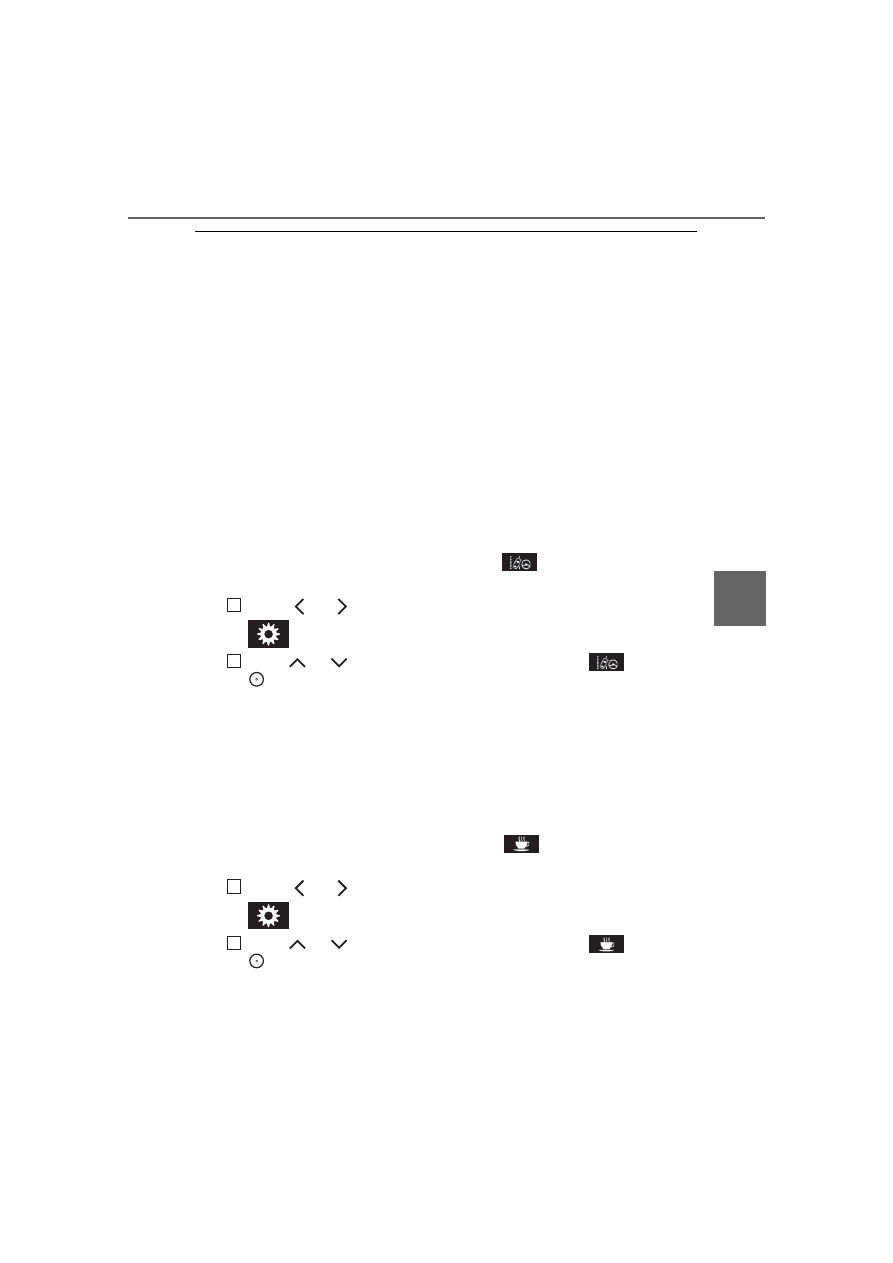
245
5-5. Using the driving support systems
5
Drivin
MIRAI_OM_USA_OM62073U
■
Operation conditions of each function
●
Lane departure alert function
This function operates when all of the following conditions are met.
• LDA is turned on.
• Vehicle speed is approximately 32 mph (50 km/h) or more.
• System recognizes white (yellow) lane lines or a course
*
. (When a white
[yellow] line or course* is recognized on only one side, the system will
operate only for the recognized side.)
• Width of traffic lane is approximately 9.8 ft. (3 m) or more.
• Turn signal lever is not operated.
• Vehicle is not being driven around a sharp curve.
• No system malfunctions are detected. (
*
: Boundary between asphalt and the side of the road, such as grass, soil, or
a curb
●
Steering assist function
This function operates when all of the following conditions are met in addi-
tion to the operation conditions for the lane departure alert function.
• Setting for “LDA Steering Assist Mode” in
on the multi-information
display (
P. 117) is set to “ON”.
Press
or
of the meter control switches (
P. 118) and select
.
Press
or
of the meter control switches, select
and press
to select the “ON”.
• Vehicle is not accelerated or decelerated by a fixed amount or more.
• Steering wheel is not operated with a steering force level suitable for
changing lanes.
• ABS, VSC, TRAC and PCS are not operating.
• TRAC or VSC is not turned off.
• Hands off steering wheel warning is not displayed. (
●
Vehicle sway warning function
This function operates when all of the following conditions are met.
• Setting for “Lane Sway Warning Status” in
on the multi-information
display (
P. 117) is set to “On”.
Press
or
of the meter control switches (
P. 118) and select
.
Press
or
of the meter control switches, select
and press
to select the “ON”.
• Vehicle speed is approximately 32 mph (50 km/h) or more.
• Width of traffic lane is approximately 9.8 ft. (3 m) or more.
• No system malfunctions are detected. (
1
2
1
2
-------------------------------------------------------------------------------------------------------------------------------------------------------------

246
5-5. Using the driving support systems
MIRAI_OM_USA_OM62073U
■
Temporary cancelation of functions
When operation conditions are no longer met, a function may be temporarily
canceled. However, when the operation conditions are met again, operation
of the function is automatically restored. (
■
Steering assist function
●
Depending on the vehicle speed, lane departure situation, road conditions,
etc., the driver may not feel the function is operating or the function may not
operate at all.
●
The steering control of the function is overridden by the driver’s steering
wheel operation.
●
Do not attempt to test the operation of the steering assist function.
■
Lane departure alert function
●
The warning buzzer may be difficult to hear due to external noise, audio
playback, etc.
●
If the edge of the course
*
is not clear or straight, the lane departure alert
function may not operate.
●
Do not attempt to test the operation of the lane departure alert function.
*
: Boundary between asphalt and the side of the road, such as grass, soil, or
a curb
■
Hands off steering wheel warning
●
When the system determines that the driver is driving without holding the
steering wheel while the system is operating
If the driver continues to keep their hands off of the steering wheel, the
buzzer sounds, the driver is warned and the function is temporarily can-
celed.
This warning also operates in the same way when the driver continuously
operates the steering wheel only a small amount.
●
When the system determines that the vehicle may not turn and instead
depart from its lane while driving around a curve
Depending on the vehicle condition and road conditions, the warning may
not operate. Also, if the system determines that the vehicle is driving
around a curve, warnings will occur earlier than during straight-lane driving.
In the following situations, a warning mes-
sage urging the driver to hold the steering
wheel and the symbol shown in the illus-
tration are displayed on the multi-informa-
tion display to warn the driver. The
warning stops when the system deter-
mines that the driver holds the steering
wheel.
Always keep your hands on the steering
wheel when using this system, regardless
of warnings.
-------------------------------------------------------------------------------------------------------------------------------------------------------------

247
5-5. Using the driving support systems
5
Drivin
MIRAI_OM_USA_OM62073U
●
When the system determines that the driver is driving without holding the
steering wheel while the steering wheel assist of the steering assist function
is operating.
If the driver continues to keep their hands off of the steering wheel and the
steering wheel assist is operating, the buzzer sounds and the driver is
warned. Each time the buzzer sounds, the continuing time of the buzzer
becomes longer.
■
Vehicle sway warning function
■
Warning message
If the following warning message is displayed on the multi-information display
and the LDA indicator illuminates in yellow, follow the appropriate trouble-
shooting procedure. Also, if a different warning message is displayed, follow
the instructions displayed on the screen.
●
“Lane Departure Alert Malfunction Visit Your Dealer”
The system may not be operating properly. Have the vehicle inspected by
your Toyota dealer.
●
“Lane Departure Alert Unavailable”
The system is temporarily canceled due to a malfunction in a sensor other
than the front camera. Turn the LDA system off, wait for a little while, and
then turn the LDA system back on.
●
”Lane Departure Alert Unavailable at Current Speed”
The function cannot be used as the vehicle speed exceeds the LDA opera-
tion range. Drive slower.
●
“Lane Departure Alert Unavailable Below Approx 32MPH”
The LDA system cannot be used as the vehicle speed is less than approxi-
mately 32 mph (50 km/h). Drive the vehicle at approximately 32 mph
(50 km/h) or more.
■
Customization
Function settings can be changed.
(Customizable features:
When the system determines that the
vehicle is swaying while the vehicle sway
warning function is operating, a buzzer
sounds and a warning message urging
the driver to rest and the symbol shown in
the illustration are simultaneously dis-
played on the multi-information display.
Depending on the vehicle and road condi-
tions, the warning may not operate.
-------------------------------------------------------------------------------------------------------------------------------------------------------------
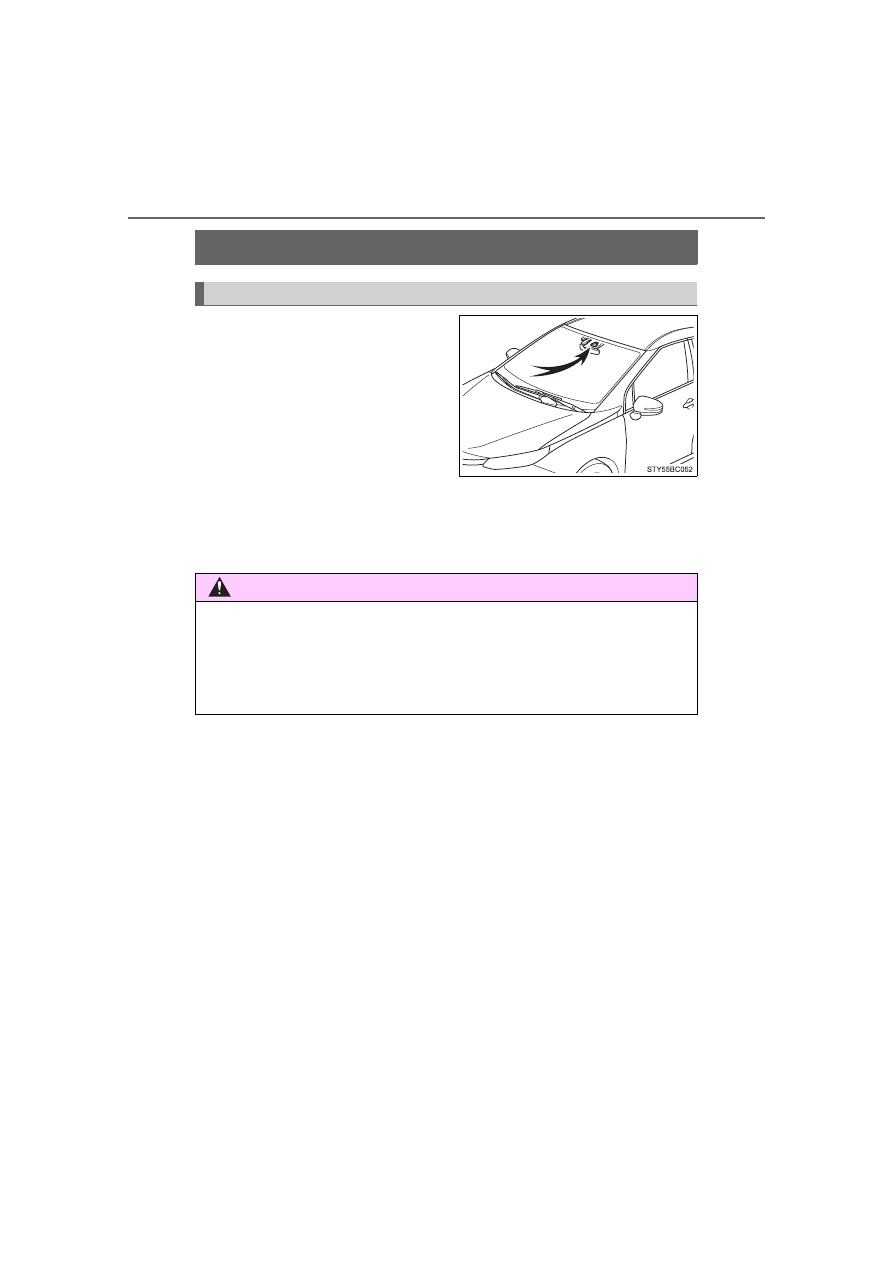
248
5-5. Using the driving support systems
MIRAI_OM_USA_OM62073U
RSA (Road Sign Assist)
The RSA system recognizes spe-
cific road signs using the front
camera to provide information to
the driver via the display.
If the system judges that the vehicle is being driven over the speed
limit, performing prohibited actions, etc., in relation to the recognized
road signs, it alerts the driver using a warning display and warning
buzzer.
: If equipped
Summary of function
WARNING
■
Before using the RSA
Do not rely solely upon the RSA system. RSA is a system which supports
the driver by providing information, but it is not a replacement for a driver’s
own vision and awareness. Drive safely by always paying careful attention
to the traffic rules.
-------------------------------------------------------------------------------------------------------------------------------------------------------------

249
5-5. Using the driving support systems
5
Drivin
MIRAI_OM_USA_OM62073U
When the front camera recognizes a sign, the sign will be displayed
on the multi-information display.
●
When the driving assist sys-
tems display is selected, a max-
imum of 2 signs can be
displayed. (
●
When a tab other than the
driving assist systems display
is selected, only a recognized
speed limit sign or do not
enter sign (when notification is
necessary) will be displayed.
(
If signs other than speed limit signs are recognized, they will be dis-
played in an overlapping stack under the current speed limit sign.
Indication on the multi-information display
-------------------------------------------------------------------------------------------------------------------------------------------------------------

250
5-5. Using the driving support systems
MIRAI_OM_USA_OM62073U
The following types of road signs are recognized.
A non-official or a recently introduced traffic sign may not be recognized.
In the following situations, the RSA system will alert the driver.
●
When the vehicle speed exceeds the speed warning threshold of
the speed limit sign displayed, the sign display will be emphasized
and a buzzer will sound.
●
When the RSA system recognizes a do not enter sign and deter-
mines that your vehicle has entered a no-entry area, the displayed
sign will flash and a buzzer will sound.
Depending on the situation, traffic environment (traffic direction,
speed unit) may be detected incorrectly and a warning display may
not operate properly.
Supported types of road signs
Speed limit
Do Not Enter
Stop
Yield
Warning display
-------------------------------------------------------------------------------------------------------------------------------------------------------------

251
5-5. Using the driving support systems
5
Drivin
MIRAI_OM_USA_OM62073U
■
Setting procedure
RSA can be enabled/disabled on the multi-information display (
P. 117).
Press
or
of the meter control switches (
P. 118) and select
.
Press
or
of the meter control switches, select
and press
to select the desired setting (on/off).
■
Automatic turn-off of RSA sign display
In the following situations, a displayed speed limit sign will stop being dis-
played automatically:
●
A new sign is not recognized for a certain distance.
●
The road changes due to a left or right turn, etc.
In the following situations, do not enter, stop and yield signs will stop being
displayed automatically:
●
The system determines that your vehicle has passed the sign.
●
The road changes due to a left or right turn, etc.
■
Conditions in which the function may not operate or detect correctly
In the following situations, RSA does not operate normally and may not rec-
ognize signs, display the incorrect sign, etc. However, this does not indicate a
malfunction.
●
The front camera is misaligned due to a strong impact being applied to the
sensor, etc.
●
Dirt, snow, stickers, etc. are on the windshield near the front camera.
●
In inclement weather such as heavy rain, fog, snow or sand storms
●
Light from an oncoming vehicle, the sun, etc. enters the front camera.
●
The sign is dirty, faded, tilted or bent.
●
All or part of the sign is hidden by the leaves of a tree, a pole, etc.
●
The sign is only visible to the front camera for a short amount of time.
●
The driving scene (turning, lane change, etc.) is judged incorrectly.
●
Even if it is a sign not appropriate for the currently traveled lane, such a sign
exists directly after a freeway branches, or in an adjacent lane just before
merging.
●
Stickers are attached to the rear of the preceding vehicle.
●
A sign resembling a system compatible sign is recognized.
●
Side road speed signs may be detected and displayed (if positioned in sight
of the front camera) while the vehicle is traveling on the main road.
1
2
-------------------------------------------------------------------------------------------------------------------------------------------------------------
252
5-5. Using the driving support systems
MIRAI_OM_USA_OM62073U
●
Roundabout exit road speed signs may be detected and displayed (if posi-
tioned in sight of the front camera) while traveling on a roundabout.
●
The front of the vehicle is raised or lowered due to the carried load.
●
The surrounding brightness is not sufficient or changes suddenly.
●
When a sign intended for trucks, etc. is recognized.
■
Speed limit sign display
If the power switch was last turned off while a speed limit sign was displayed
on the multi-information display, the same sign displays again when the
power switch is turned to ON mode.
■
If “RSA Malfunction Visit Your Dealer” is shown
The system may be malfunctioning. Have the vehicle inspected by your
Toyota dealer.
■
Customization
Some functions can be customized.
(Customizable features:
-------------------------------------------------------------------------------------------------------------------------------------------------------------
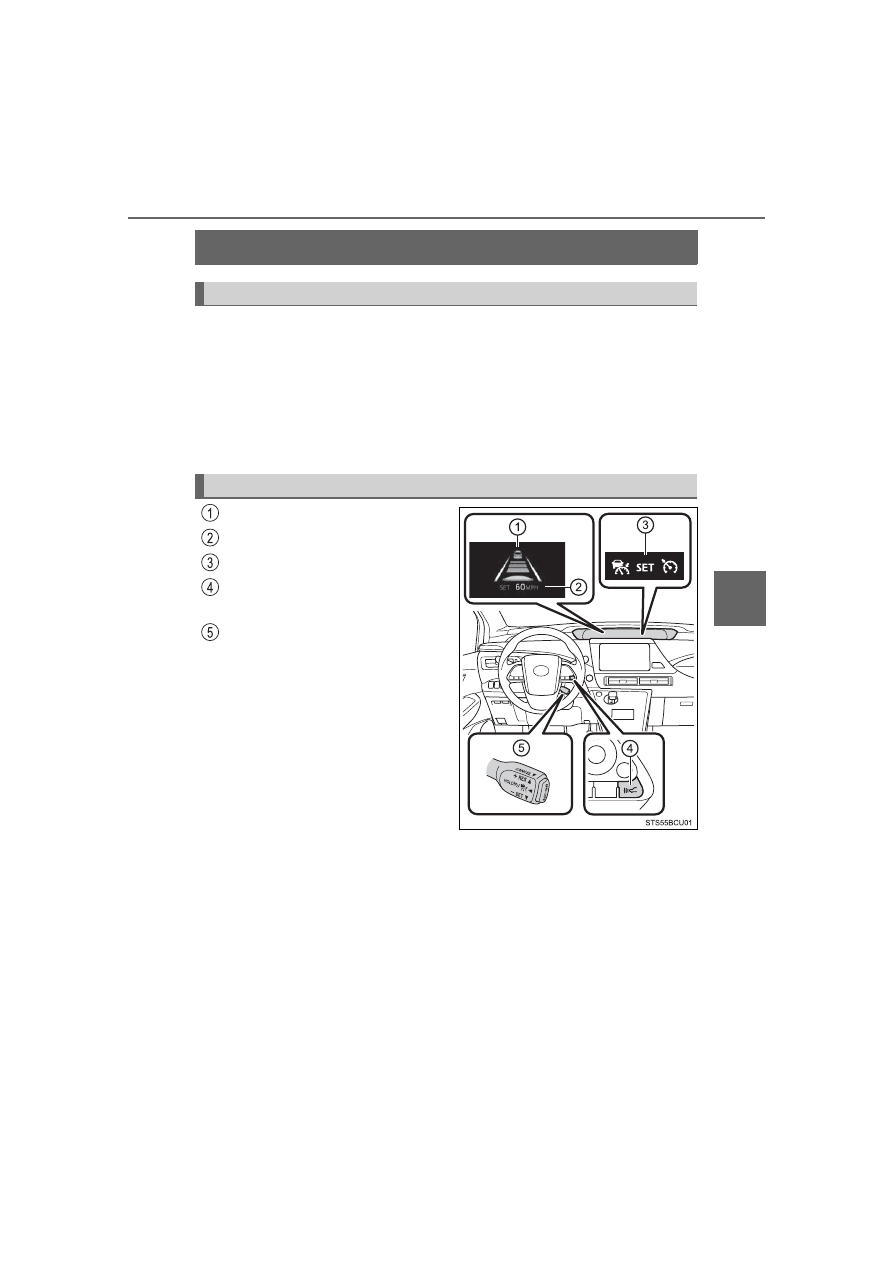
253
5-5. Using the driving support systems
5
Drivin
MIRAI_OM_USA_OM62073U
Dynamic radar cruise control
In vehicle-to-vehicle distance control mode, the vehicle automatically
accelerates and decelerates to match the speed changes of the pre-
ceding vehicle even if the accelerator pedal is not depressed. In con-
stant speed control mode, the vehicle runs at a fixed speed.
Use the dynamic radar cruise control on freeways and highways.
●
Vehicle-to-vehicle distance control mode (
●
Constant speed control mode (
Multi-information display
Set speed
Indicators
Vehicle-to-vehicle
distance
switch
Cruise control switch
Summary of functions
System Components
-------------------------------------------------------------------------------------------------------------------------------------------------------------
254
5-5. Using the driving support systems
MIRAI_OM_USA_OM62073U
WARNING
■
Before using dynamic radar cruise control
●
Driving safely is the sole responsibility of the driver. Do not rely solely on
the system, and drive safely by always paying careful attention to your sur-
roundings.
●
The dynamic radar cruise control provides driving assistance to reduce the
driver’s burden. However, there are limitations to the assistance provided.
Read the following conditions carefully. Do not overly rely on this system
and always drive carefully.
• When the sensor may not be correctly detecting the vehicle ahead:
• Conditions under which the vehicle-to-vehicle distance control mode
may not function correctly:
●
Set the speed appropriately depending on the speed limit, traffic flow, road
conditions, weather conditions, etc. The driver is responsible for checking
the set speed.
●
Even when the system is functioning normally, the condition of the preced-
ing vehicle as detected by the system may differ from the condition
observed by the driver. Therefore, the driver must always remain alert,
assess the danger of each situation and drive safely. Relying solely on this
system or assuming the system ensures safety while driving can lead to
an accident, resulting in death or serious injury.
●
Switch the dynamic radar cruise control setting to off, using the “ON-OFF”
button when not in use.
■
Cautions regarding the driving assist systems
Observe the following precautions, as there are limitations to the assistance
provided by the system. Failure to do so may cause an accident resulting in
death or serious injury.
●
Assisting the driver to measure following distance
The dynamic radar cruise control is only intended to help the driver in
determining the following distance between the driver’s own vehicle and a
designated vehicle traveling ahead. It is not a mechanism that allows
careless or inattentive driving, and it is not a system that can assist the
driver in low-visibility conditions.
It is still necessary for driver to pay close attention to the vehicle’s sur-
roundings.
-------------------------------------------------------------------------------------------------------------------------------------------------------------
255
5-5. Using the driving support systems
5
Drivin
MIRAI_OM_USA_OM62073U
WARNING
●
Assisting the driver to judge proper following distance
The dynamic radar cruise control determines whether the following dis-
tance between the driver’s own vehicle and a designated vehicle traveling
ahead is within a set range. It is not capable of making any other type of
judgement.Therefore, it is absolutely necessary for the driver to remain
vigilant and to determine whether or not there is a possibility of danger in
any given situation.
●
Assisting the driver to operate the vehicle
The dynamic radar cruise control does not include functions which will
prevent or avoid collisions with vehicles ahead of your vehicle. Therefore,
if there is ever any possibility of danger, the driver must take immediate
and direct control of the vehicle and act appropriately in order to ensure
the safety of all involved.
■
Situations unsuitable for dynamic radar cruise control
Do not use dynamic radar cruise control in any of the following situations.
Doing so may result in inappropriate speed control and could cause an acci-
dent resulting in death or serious injury.
●
Roads where there are pedestrians, cyclists, etc.
●
In heavy traffic
●
On roads with sharp bends
●
On winding roads
●
On slippery roads, such as those covered with rain, ice or snow
●
On steep downhills, or where there are sudden changes between sharp up
and down gradients
Vehicle speed may exceed the set speed when driving down a steep hill.
●
At entrances to freeways and highways
●
When weather conditions are bad enough that they may prevent the sen-
sors from detecting correctly (fog, snow, sandstorm, heavy rain, etc.)
●
When there is rain, snow, etc. on the front surface of the radar or front
camera
●
In traffic conditions that require frequent repeated acceleration and decel-
eration
●
During emergency towing
●
When an approach warning buzzer is heard often
-------------------------------------------------------------------------------------------------------------------------------------------------------------
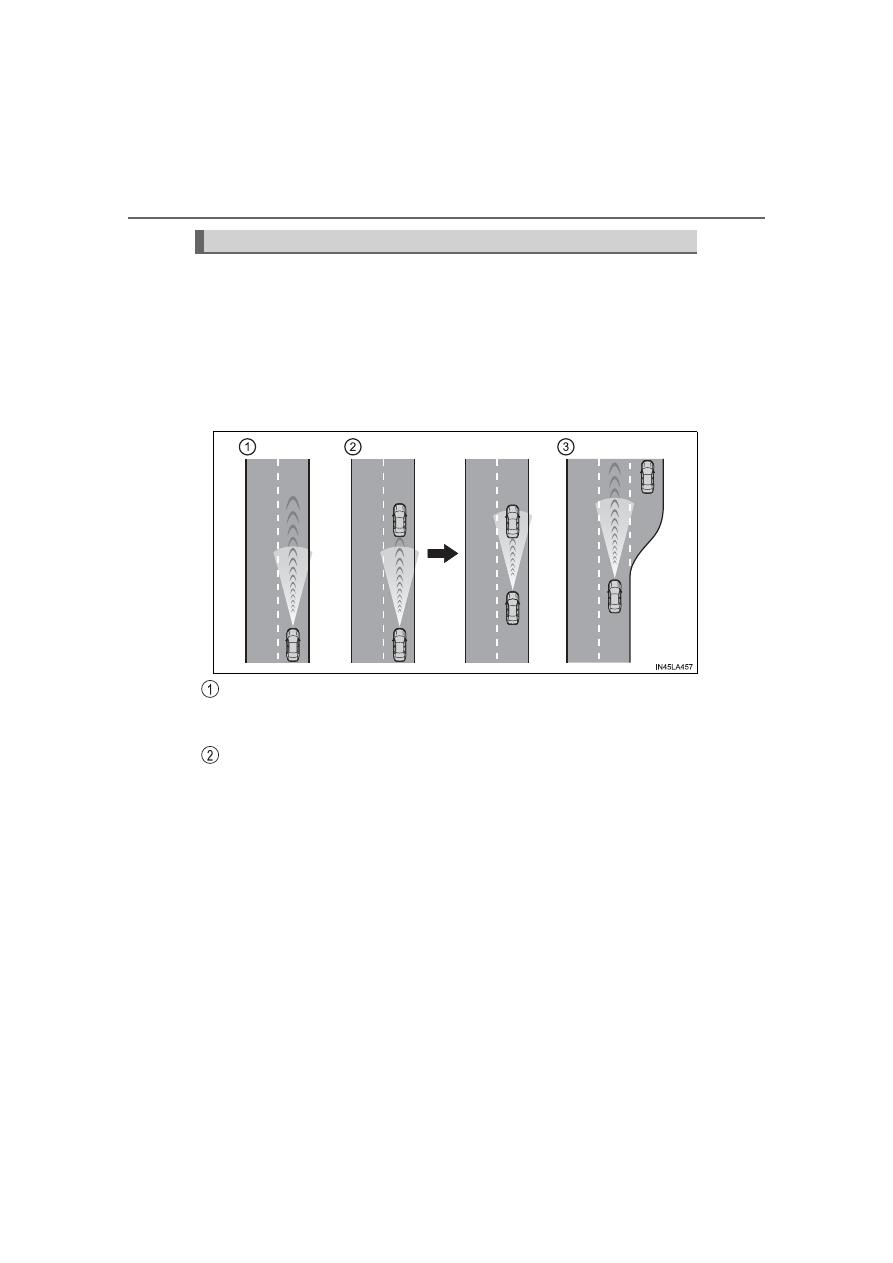
256
5-5. Using the driving support systems
MIRAI_OM_USA_OM62073U
This mode employs a radar to detect the presence of vehicles up to
approximately 328 ft. (100 m) ahead, determines the current vehicle-
to-vehicle following distance, and operates to maintain a suitable fol-
lowing distance from the vehicle ahead. The desired vehicle-to-vehicle
distance can also be set by operating the vehicle-to-vehicle distance
switch.
When driving on downhill slopes, the vehicle-to-vehicle distance may
become shorter.
Example of constant speed cruising
When there are no vehicles ahead
The vehicle travels at the speed set by the driver.
Example of deceleration cruising and follow-up cruising
When a preceding vehicle driving slower than the set speed
appears
When a vehicle is detected running ahead of you, the system automatically
decelerates your vehicle. When a greater reduction in vehicle speed is
necessary, the system applies the brakes (the stop lights will come on at
this time).
The system will respond to changes in the speed of the vehicle ahead in
order to maintain the vehicle-to-vehicle distance set by the driver.
Approach warning warns you when the system cannot decelerate suffi-
ciently to prevent your vehicle from closing in on the vehicle ahead.
When the turn signal lever is operated and your vehicle moves to a left
lane while driving at 50 mph (80 km/h) or more, the vehicle will quickly
accelerate to help to overtake a passing vehicle.
Driving in vehicle-to-vehicle distance control mode
-------------------------------------------------------------------------------------------------------------------------------------------------------------
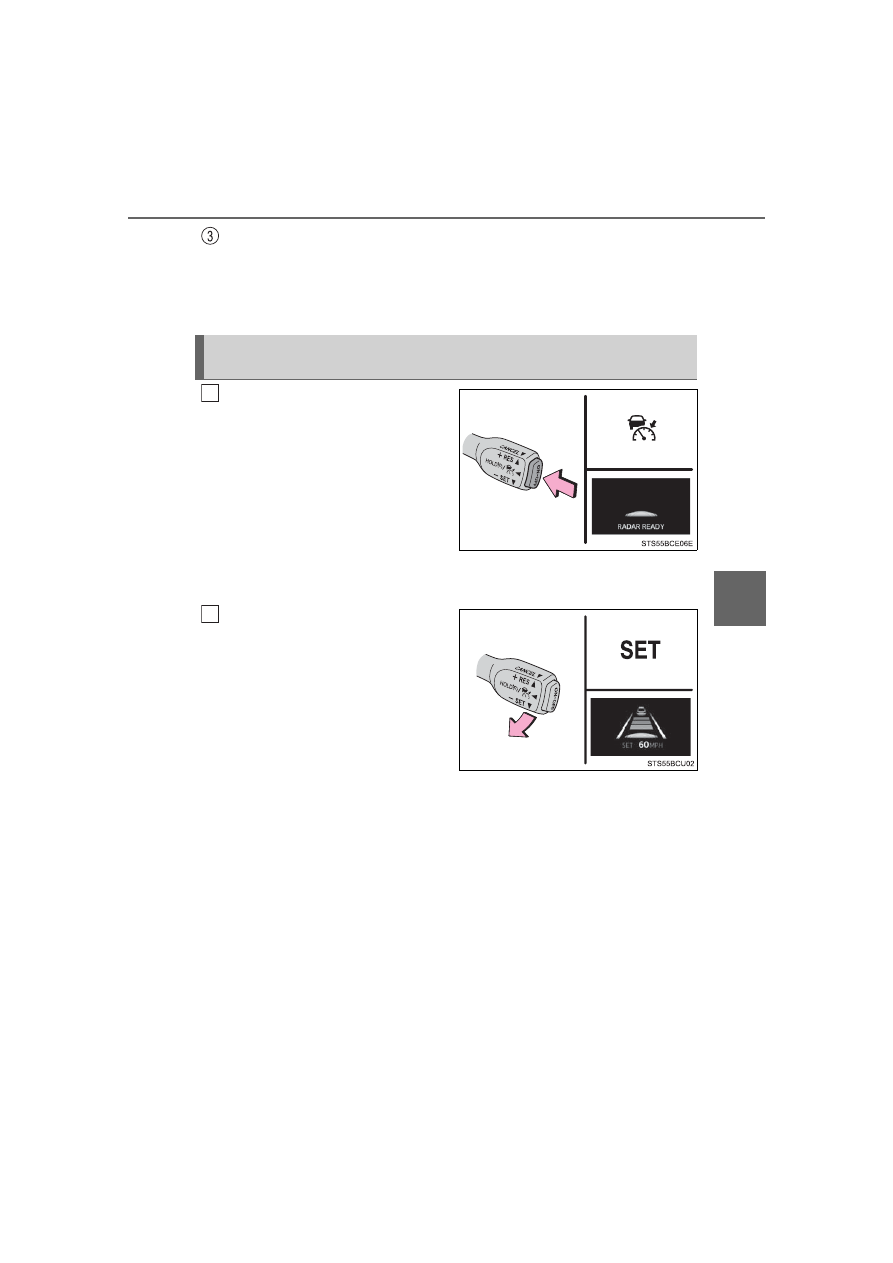
257
5-5. Using the driving support systems
5
Drivin
MIRAI_OM_USA_OM62073U
Example of acceleration
When there are no longer any preceding vehicles driving slower
than the set speed
The system accelerates until the set speed is reached. The system then
returns to constant speed cruising.
Press the “ON-OFF” button to
activate the cruise control.
Dynamic radar cruise control indi-
cator will come on and a message
will be displayed on the multi-infor-
mation display. Press the button
again to deactivate the cruise con-
trol.
If the “ON-OFF” button is pressed
and held for 1.5 seconds or more,
the system turns on in constant
speed control mode. (
Accelerate or decelerate, with
accelerator pedal operation, to
the desired vehicle speed (at or
above approximately 20 mph
[30 km/h]) and push the lever
down to set the speed.
Cruise control “SET” indicator will
come on.
The vehicle speed at the moment the lever is released becomes the set
speed.
Setting the vehicle speed (vehicle-to-vehicle distance control
mode)
1
2
-------------------------------------------------------------------------------------------------------------------------------------------------------------
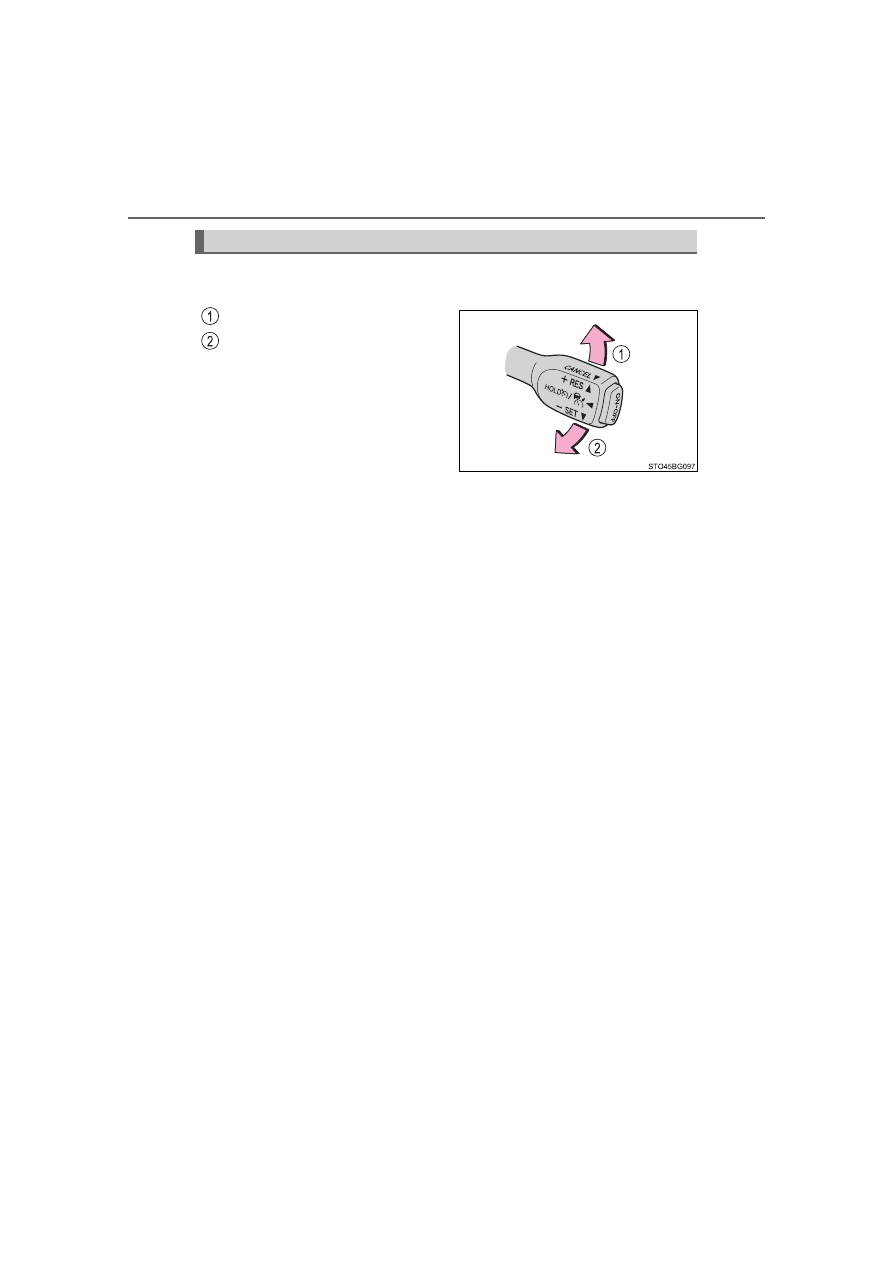
258
5-5. Using the driving support systems
MIRAI_OM_USA_OM62073U
To change the set speed, operate the lever until the desired set speed
is displayed.
Increases the speed
Decreases the speed
Fine
adjustment:
Momentarily
move the lever in the desired direc-
tion.
Large adjustment: Hold the lever
up or down to change the speed,
and release when the desired
speed is reached.
In the vehicle-to-vehicle distance control mode, the set speed will be
increased or decreased as follows:
For U.S.A.
Fine adjustment: By 1 mph (1.6 km/h)
*
1
or 1 km/h (0.6 mph)
*
2
each time
the lever is operated
Large adjustment: Increases or decreases in 1 mph (1.6 km/h)
*
1
or 1 km/h
(0.6 mph)
*
2
increments for as long as the lever is held
For Canada
Fine adjustment: By 1 mph (1.6 km/h)
*
1
or 1 km/h (0.6 mph)
*
2
each time
the lever is operated
Large adjustment: Increases or decreases in 5 mph (8 km/h)
*
1
or 5 km/h
(3.1 mph)
*
2
increments for as long as the lever is held
In the constant speed control mode (
P. 257), the set speed will be
increased or decreased as follows:
Fine adjustment: By 1 mph (1.6 km/h)
*
1
or 1 km/h (0.6 mph)
*
2
each time
the lever is operated
Large adjustment: The speed will continue to change while the lever is
held.
*
1
: When the set speed is shown in “MPH”
*
2
: When the set speed is shown in “km/h”
Adjusting the set speed
-------------------------------------------------------------------------------------------------------------------------------------------------------------
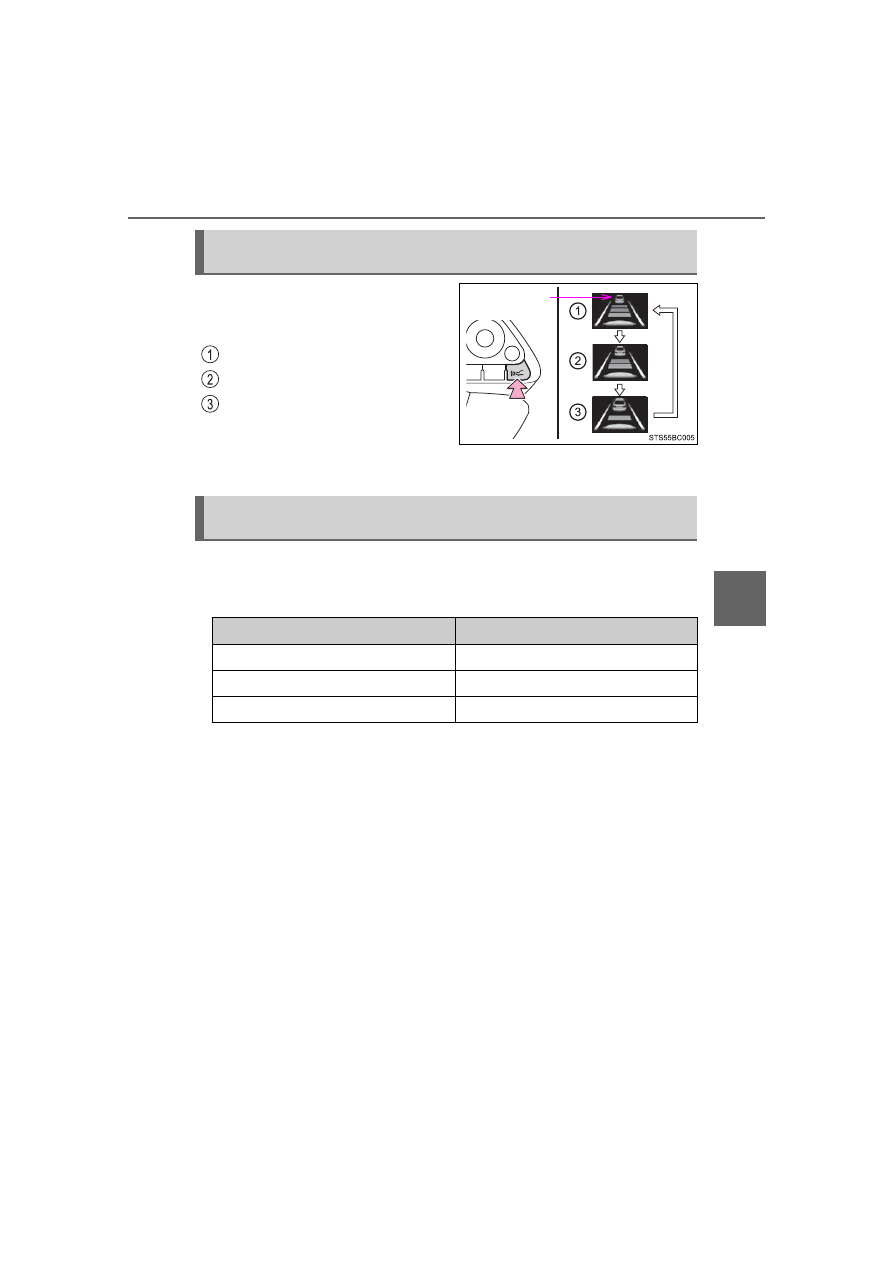
259
5-5. Using the driving support systems
5
Drivin
MIRAI_OM_USA_OM62073U
Pressing the switch changes the
vehicle-to-vehicle distance as fol-
lows:
Long
Medium
Short
The vehicle-to-vehicle distance is
set automatically to long mode
when the power switch is turned to
ON mode.
Select a distance from the table below. Note that the distances shown
correspond to a vehicle speed of 50 mph (80 km/h). Vehicle-to-vehicle
distance increases/decreases in accordance with vehicle speed.
Changing the vehicle-to-vehicle distance (vehicle-to-vehicle dis-
tance control mode)
Preceding
vehicle mark
Vehicle-to-vehicle distance settings (vehicle-to-vehicle distance
control mode)
Distance options
Vehicle-to-vehicle distance
Long
Approximately 160 ft. (50 m)
Medium
Approximately 130 ft. (40 m)
Short
Approximately 100 ft. (30 m)
-------------------------------------------------------------------------------------------------------------------------------------------------------------
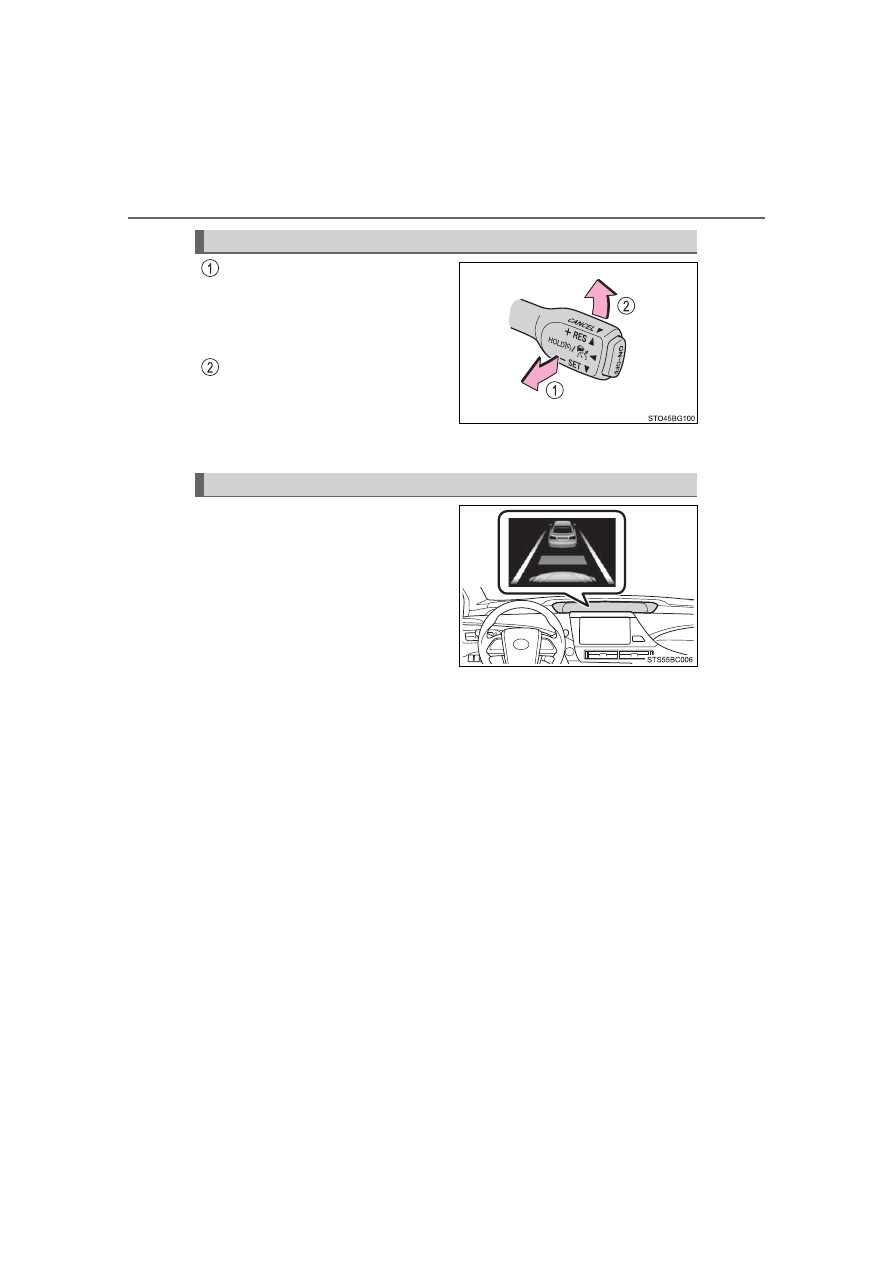
260
5-5. Using the driving support systems
MIRAI_OM_USA_OM62073U
Pulling the lever toward you
cancels the speed control.
The speed control is also canceled
when
the
brake
pedal
is
depressed.
Pushing the lever up resumes
the cruise control and returns
vehicle speed to the set speed.
However, cruise control does not resume when the vehicle speed is
approximately 16 mph (25 km/h) or less.
When your vehicle is too close to
a vehicle ahead, and sufficient
automatic deceleration via the
cruise control is not possible, the
display will flash and the buzzer
will sound to alert the driver. An
example of this would be if
another driver cuts in front of you
while you are following a vehicle.
Depress the brake pedal to ensure an appropriate vehicle-to-vehicle
distance.
■
Warnings may not occur when
In the following instances, warnings may not occur even when the
vehicle-to-vehicle distance is small.
●
When the speed of the preceding vehicle matches or exceeds
your vehicle speed
●
When the preceding vehicle is traveling at an extremely slow
speed
●
Immediately after the cruise control speed was set
●
When depressing the accelerator pedal
Canceling and resuming the speed control
Approach warning (vehicle-to-vehicle distance control mode)
-------------------------------------------------------------------------------------------------------------------------------------------------------------
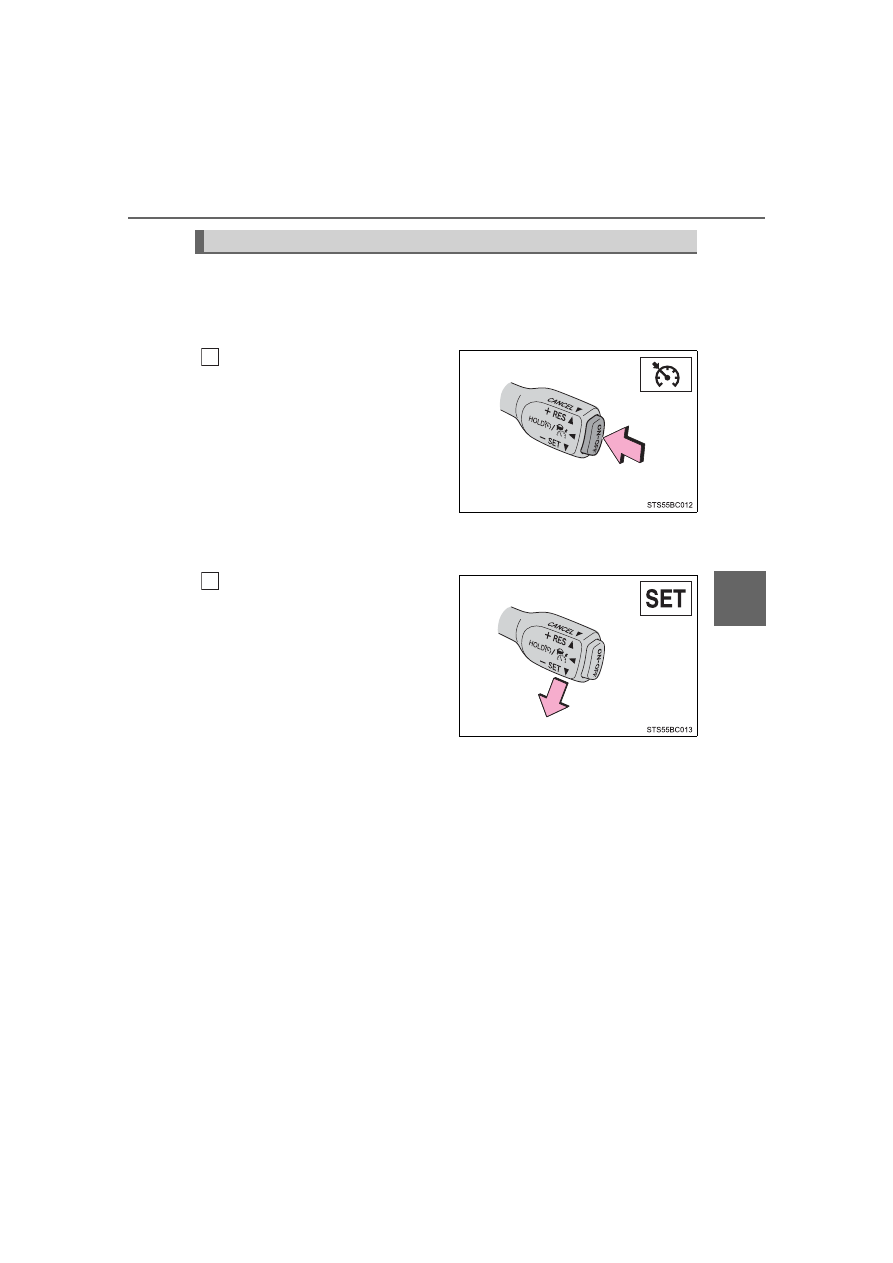
261
5-5. Using the driving support systems
5
Drivin
MIRAI_OM_USA_OM62073U
When constant speed control mode is selected, your vehicle will main-
tain a set speed without controlling the vehicle-to-vehicle distance.
Select this mode only when vehicle-to-vehicle distance control mode
does not function correctly due to a dirty radar, etc.
With the cruise control off,
press and hold the “ON-OFF”
button for 1.5 seconds or more.
Immediately after the “ON-OFF”
button is pressed, the dynamic
radar cruise control indicator will
come on. Afterwards, it switches to
the cruise control indicator.
Switching to constant speed con-
trol mode is only possible when
operating the lever with the cruise
control off.
Accelerate or decelerate, with
accelerator pedal operation, to
the desired vehicle speed (at or
above approximately 20 mph
[30km/h]) and push the lever
down to set the speed.
Cruise control “SET” indicator will
come on.
The vehicle speed at the moment the lever is released becomes the set
speed.
Adjusting the speed setting:
Canceling and resuming the speed setting:
Selecting constant speed control mode
1
2
-------------------------------------------------------------------------------------------------------------------------------------------------------------
262
5-5. Using the driving support systems
MIRAI_OM_USA_OM62073U
■
Dynamic radar cruise control can be set when
●
The shift position is in D.
●
Depending on the control mode, this item can be set at the following
speeds.
• Vehicle-to-vehicle distance control mode: Approximately 20 mph (30 km/h)
or more
• Constant speed control mode: Approximately 20 mph (30 km/h) or more
■
Accelerating after setting the vehicle speed
The vehicle can accelerate by operating the accelerator pedal. After acceler-
ating, the set speed resumes. However, during vehicle-to-vehicle distance
control mode, the vehicle speed may decrease below the set speed in order
to maintain the distance to the preceding vehicle.
■
Automatic cancelation of vehicle-to-vehicle distance control mode
Vehicle-to-vehicle distance control mode is automatically canceled in the fol-
lowing situations.
●
Actual vehicle speed falls below approximately 16 mph (25 km/h).
●
VSC is activated.
●
TRAC is activated for a period of time.
●
When the VSC or TRAC system is turned off.
●
The sensor cannot detect correctly because it is covered in some way.
●
Pre-collision braking is activated.
If vehicle-to-vehicle distance control mode is automatically canceled for any
reasons other than the above, there may be a malfunction in the system.
Contact your Toyota dealer.
■
Automatic cancelation of constant speed control mode
Constant speed control mode is automatically canceled in the following situa-
tions:
●
Actual vehicle speed is more than approximately 10 mph (16 km/h) below
the set vehicle speed.
●
Actual vehicle speed falls below approximately 20 mph (30 km/h).
●
VSC is activated.
●
TRAC is activated for a period of time.
●
When the VSC or TRAC system is turned off.
●
Pre-collision braking is activated.
If constant speed control mode is automatically canceled for any reasons
other than the above, there may be a malfunction in the system. Contact your
Toyota dealer.
■
Brake operation
A brake operation sound may be heard and the brake pedal response may
change, but these are not malfunctions.
-------------------------------------------------------------------------------------------------------------------------------------------------------------
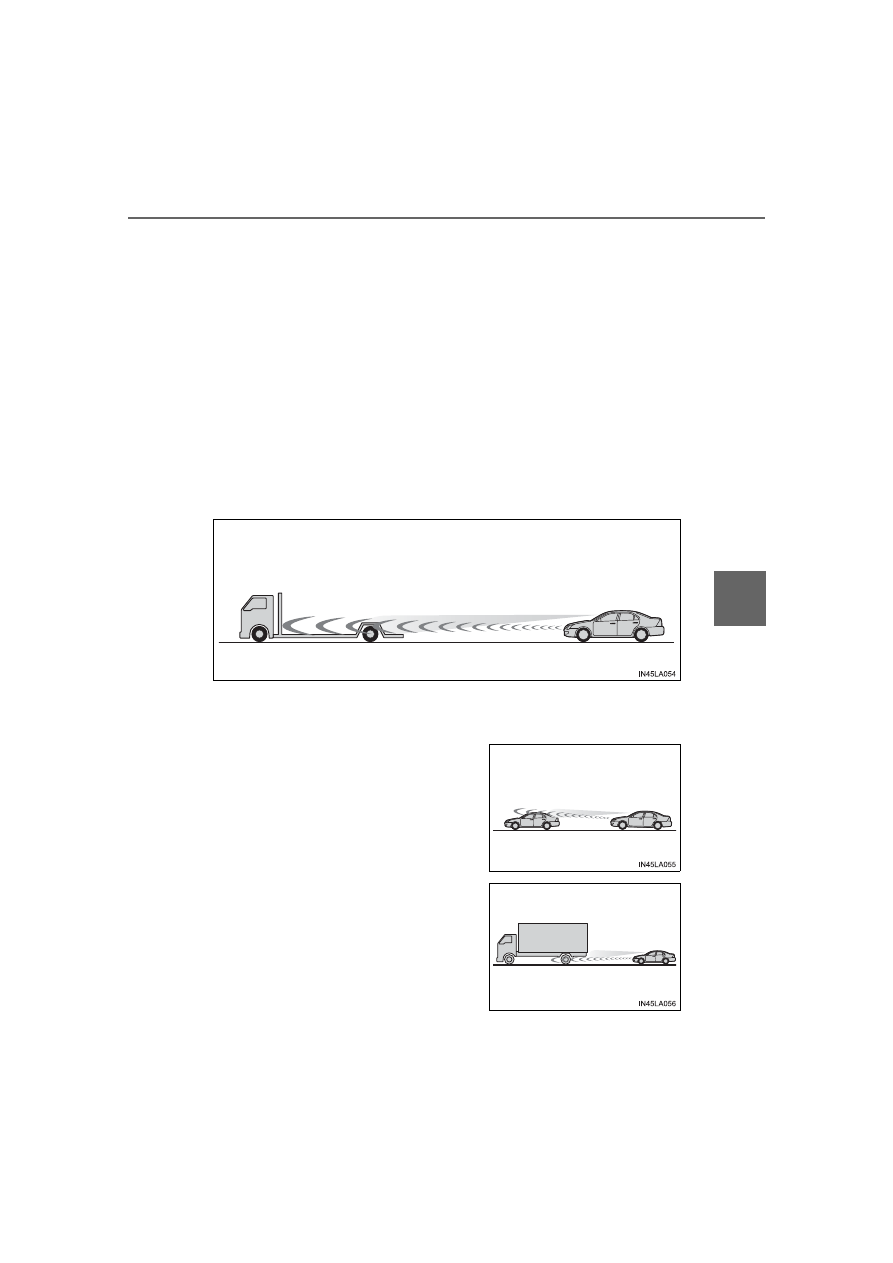
263
5-5. Using the driving support systems
5
Drivin
MIRAI_OM_USA_OM62073U
■
Warning messages and buzzers for dynamic radar cruise control
Warning messages and buzzers are used to indicate a system malfunction or
to inform the driver of the need for caution while driving. If a warning message
is shown on the multi-information display, read the message and follow the
instructions. (
■
When the sensor may not be correctly detecting the vehicle ahead
In the case of the following and depending on the conditions, operate the
brake pedal when deceleration of the system is insufficient or operate the
accelerator pedal when acceleration is required.
As the sensor may not be able to correctly detect these types of vehicles, the
approach warning (
●
Vehicles that cut in suddenly
●
Vehicles traveling at low speeds
●
Vehicles that are not moving in the same lane
●
Vehicles with small rear ends (trailers with no load on board, etc.)
●
Motorcycles traveling in the same lane
●
When water or snow thrown up by the surrounding vehicles hinders the
detecting of the sensor
●
When your vehicle is pointing upwards
(caused by a heavy load in the luggage
compartment, etc.)
●
Preceding vehicle has an extremely high
ground clearance
-------------------------------------------------------------------------------------------------------------------------------------------------------------

264
5-5. Using the driving support systems
MIRAI_OM_USA_OM62073U
■
Conditions under which the vehicle-to-vehicle distance control mode
may not function correctly
In the case of the following conditions, operate the brake pedal (or accelera-
tor pedal, depending on the situation) as necessary.
As the sensor may not be able to correctly detect vehicles ahead, the system
may not operate properly.
●
When the vehicle ahead of you decelerates suddenly
●
When driving on a road surrounded by a structure, such as in a tunnel or on
a bridge
●
While the vehicle speed is decreasing to the set speed after the vehicle
accelerates by depressing the accelerator pedal
●
When the road curves or when the lanes
are narrow
●
When steering wheel operation or your
position in the lane is unstable
-------------------------------------------------------------------------------------------------------------------------------------------------------------
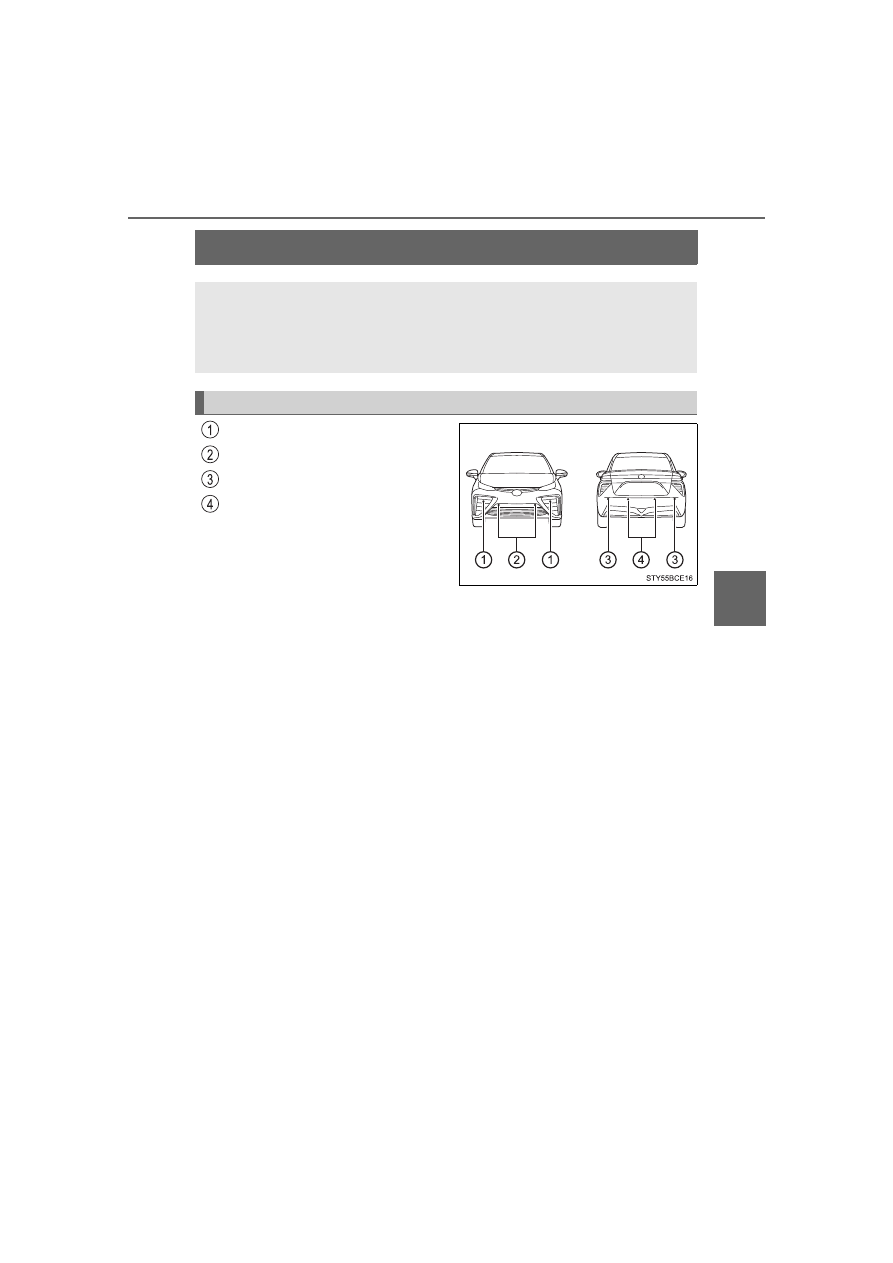
265
5-5. Using the driving support systems
5
Drivin
MIRAI_OM_USA_OM62073U
Intuitive parking assist
Front corner sensors
Front center sensors
Rear corner sensors
Rear center sensors
The distance from your vehicle to nearby obstacles when paral-
lel parking or maneuvering into a garage is measured by the
sensors and communicated via the displays and a buzzer.
Always check the surrounding area when using this system.
Types of sensors
-------------------------------------------------------------------------------------------------------------------------------------------------------------
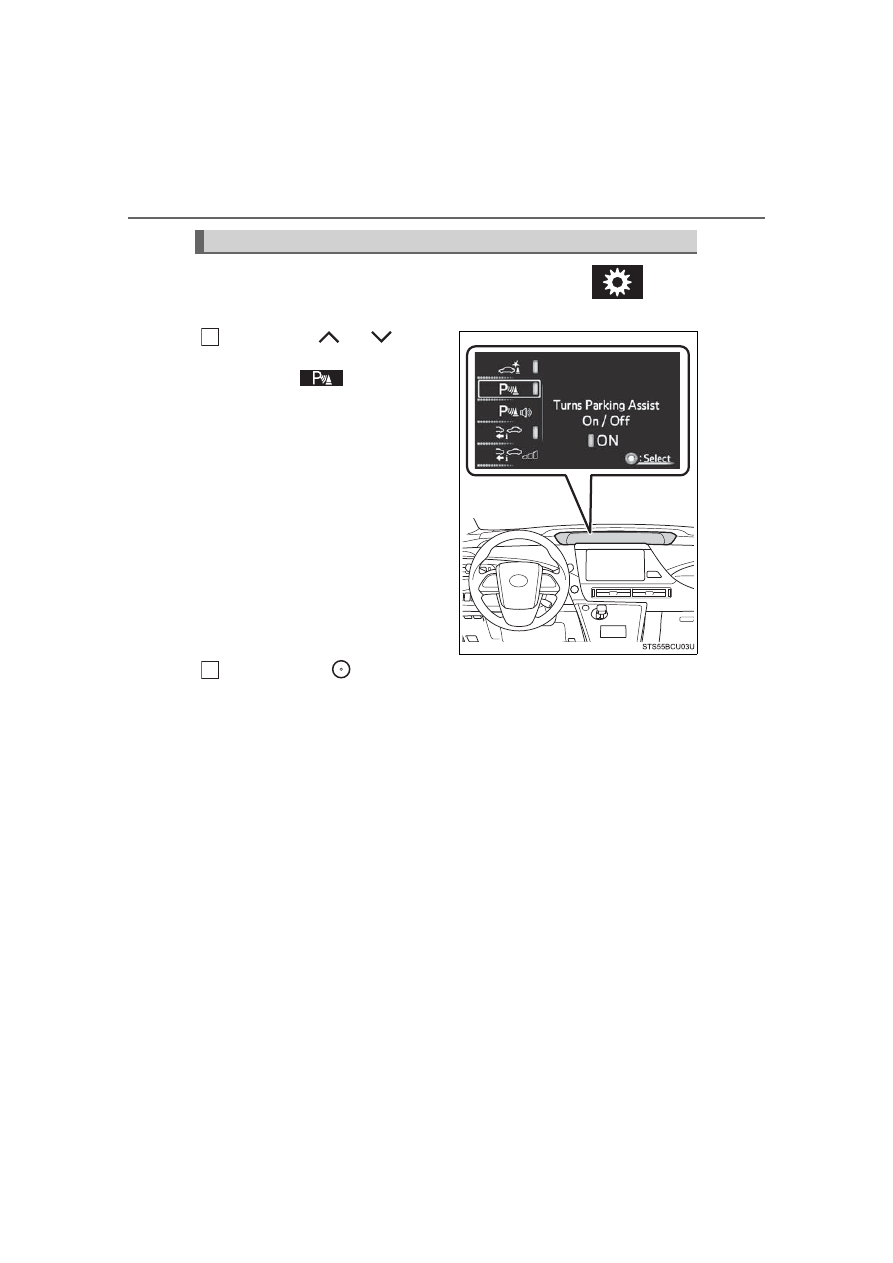
266
5-5. Using the driving support systems
MIRAI_OM_USA_OM62073U
ON (activate)/OFF (deactivate) can be changed by the
for the
Multi-information Display (
Press either
or
on the
meter control switches (
and select
.
Each press of
of the meter control switches, changes ON and
OFF. When ON is selected, the intuitive parking assist indicator
turns on.
Turning the intuitive parking assist system on
1
2
-------------------------------------------------------------------------------------------------------------------------------------------------------------
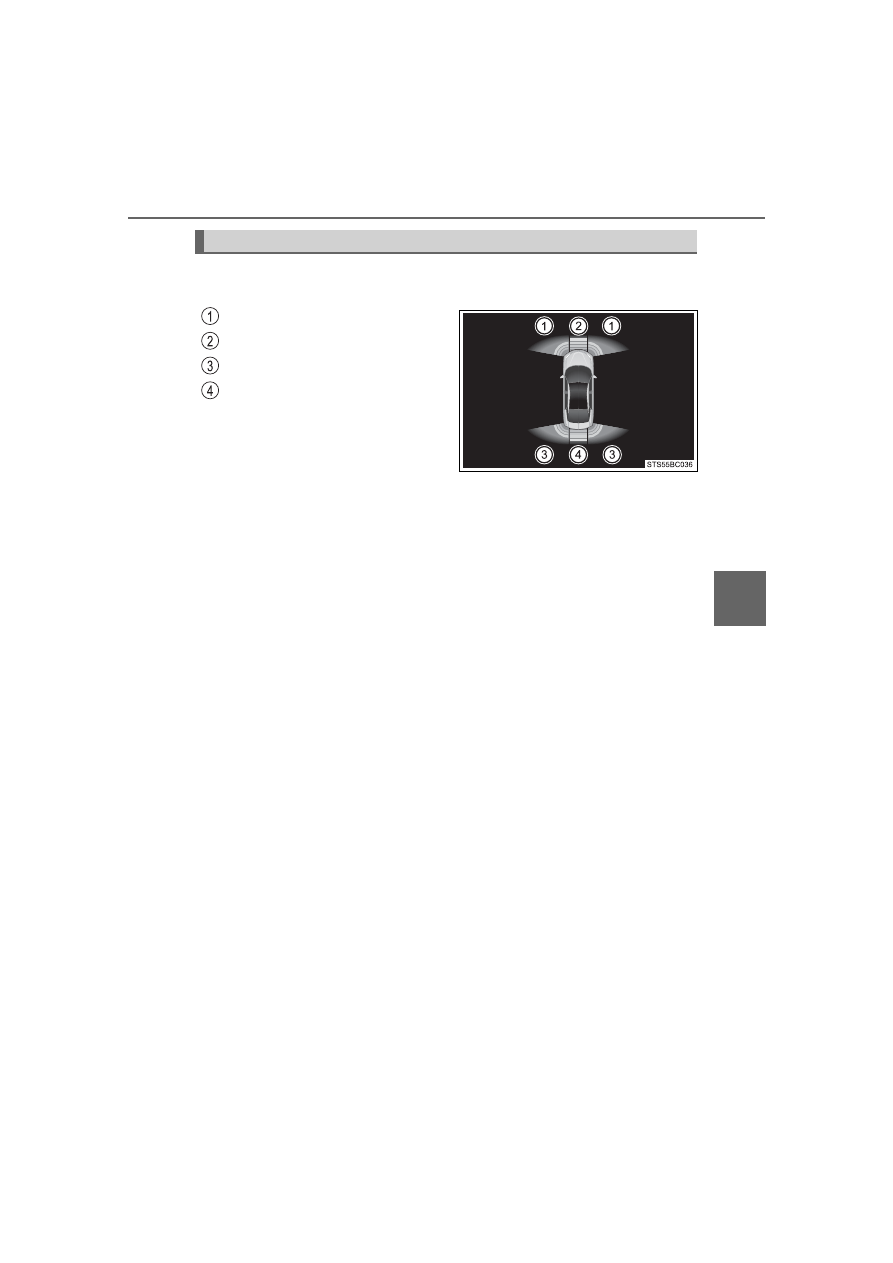
267
5-5. Using the driving support systems
5
Drivin
MIRAI_OM_USA_OM62073U
When the sensors detect an obstacle, the following displays inform
the driver of the position and distance to the obstacle.
Front corner sensor operation
Front center sensor operation
Rear corner sensor operation
Rear center sensor operation
Display
-------------------------------------------------------------------------------------------------------------------------------------------------------------

268
5-5. Using the driving support systems
MIRAI_OM_USA_OM62073U
■
Distance display
Sensors that detect an obstacle will illuminate continuously or blink.
*
: The images may differ from that shown in the illustrations. (
Sensor detection display, obstacle distance
Display
*
Approximate distance to obstacle
Front corner sensor/
front center sensor
Rear corner sensor/rear
center sensor
(continuous)
Front center sensor only:
3.2 ft. (100 cm) to
2.0 ft. (60 cm)
Rear center sensor only:
4.9 ft. (150 cm) to
2.0 ft. (60 cm)
(continuous)
2.0 ft. (60 cm) to
1.5 ft. (45 cm)
2.0 ft. (60 cm) to
1.5 ft. (45 cm)
(continuous)
1.5 ft. (45 cm) to
1.2 ft. (35 cm)
1.5 ft. (45 cm) to
1.2 ft. (35 cm)
(blinking)
Less than
1.2 ft. (35 cm)
Less than
1.2 ft. (35 cm)
-------------------------------------------------------------------------------------------------------------------------------------------------------------
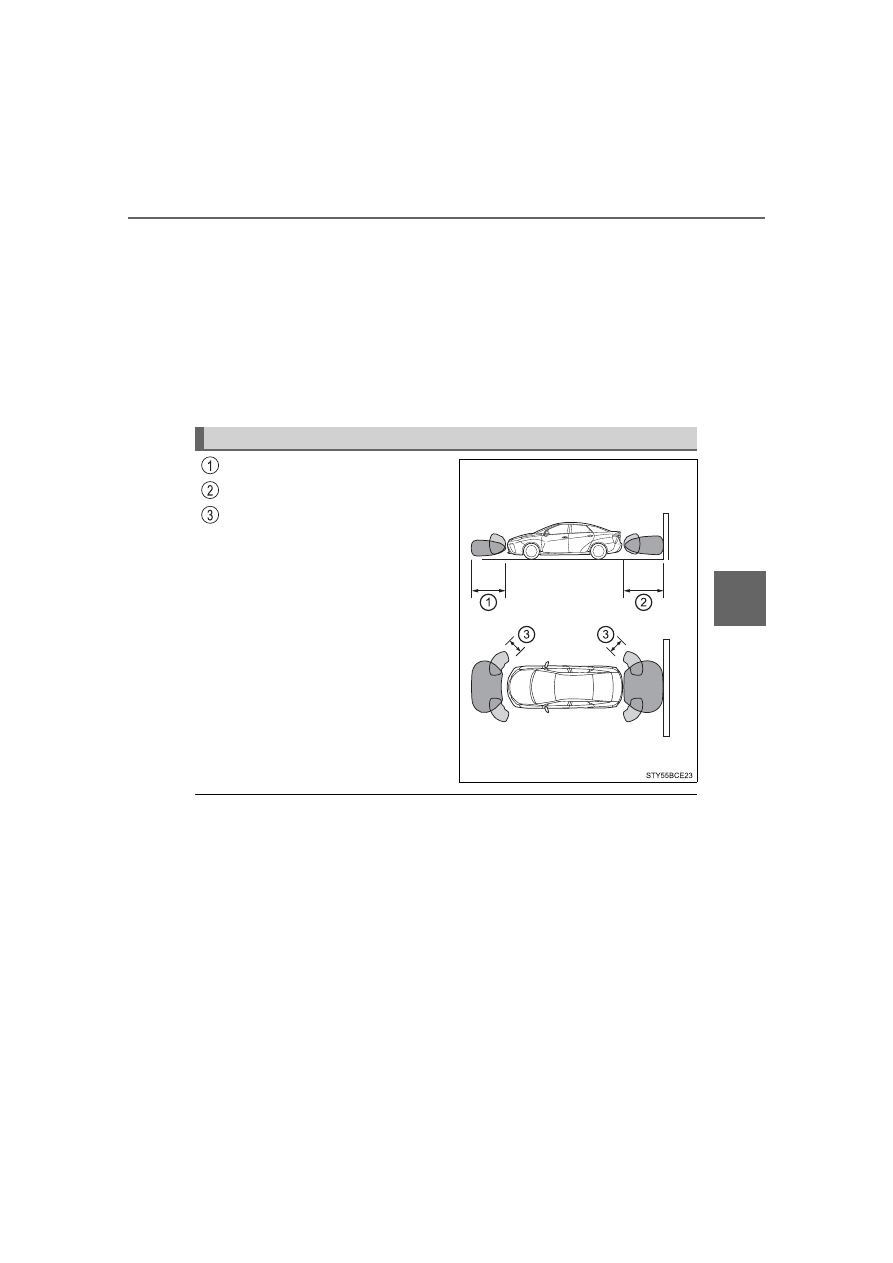
269
5-5. Using the driving support systems
5
Drivin
MIRAI_OM_USA_OM62073U
■
Buzzer operation and distance to an obstacle
A buzzer sounds when the sensors are operating.
●
The buzzer sounds faster as the vehicle approaches an obstacle.
When the vehicle comes within the approximately 1.2 ft. (35 cm)
of the obstacle, the buzzer sounds continuously.
●
When 2 or more obstacles are detected simultaneously, the
buzzer system responds to the nearest obstacle. If one or both
come within the above distances, the beep will repeat a long
tone, followed by fast beeps.
Approximately 3.2 ft. (100 cm)
Approximately 4.9 ft. (150 cm)
Approximately 2.0 ft. (60 cm)
The diagram shows the detection
range of the sensors. Note that the
sensors cannot detect obstacles
that are extremely close to the
vehicle.
The range of the sensors may
change depending on the shape of
the object, etc.
■
The intuitive parking assist can be operated when
●
The power switch is in ON mode
●
Intuitive parking assist system is on
●
The vehicle speed is less than about 6 mph (10 km/h)
●
The shift position is following positions.
• Front corner sensors: The shift position is in other than P
• Front center sensors: The shift position is in other than P or R
• Rear corner and rear center sensors: The shift position is in R
Detection range of the sensors
-------------------------------------------------------------------------------------------------------------------------------------------------------------

Нет комментариевНе стесняйтесь поделиться с нами вашим ценным мнением.
Текст